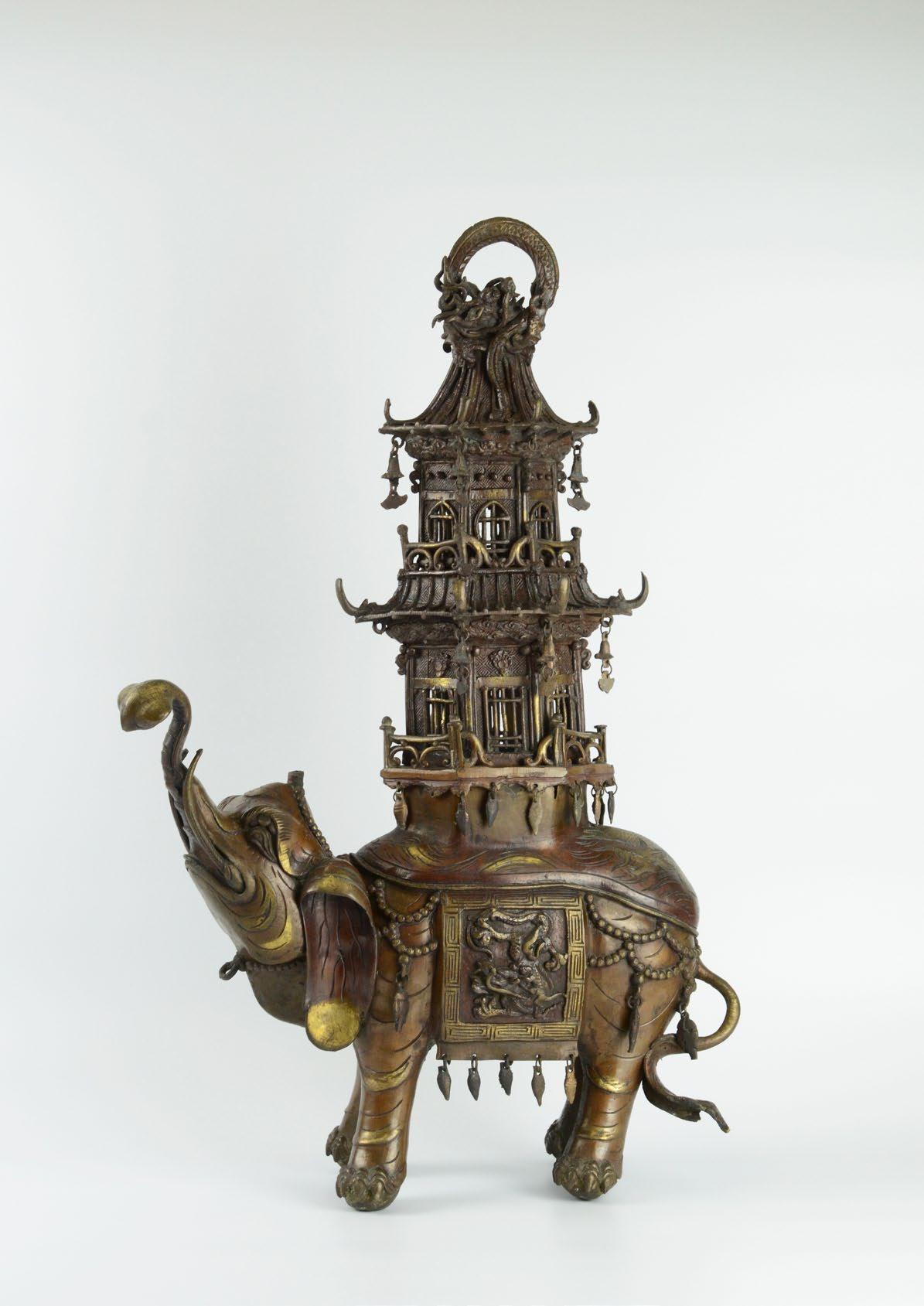april ar TWO r K s
pieces are published and changed each month. the objects are presented with a full description and corresponding dealers contact information unlike auction sites or other platforms, we empower collectors to interact directly with the member dealers for enquiries and purchases by clicking on the e-mail adress. in order to guarantee the quality of pieces available in the catalogues, objects are systematically validated by all our select members, who are the in-house experts. Collectors are therefore encouraged to decide and buy with complete confidence. in addition to this the Asian Art Society proposes a seven-day full money back return policy should the buyer not feel totally satisfied with a purchase. items are presented by categories please check the table of contents.
Feel free to ask the price if the artwork is listed with a price on request.
april 2023 - 7
SA le
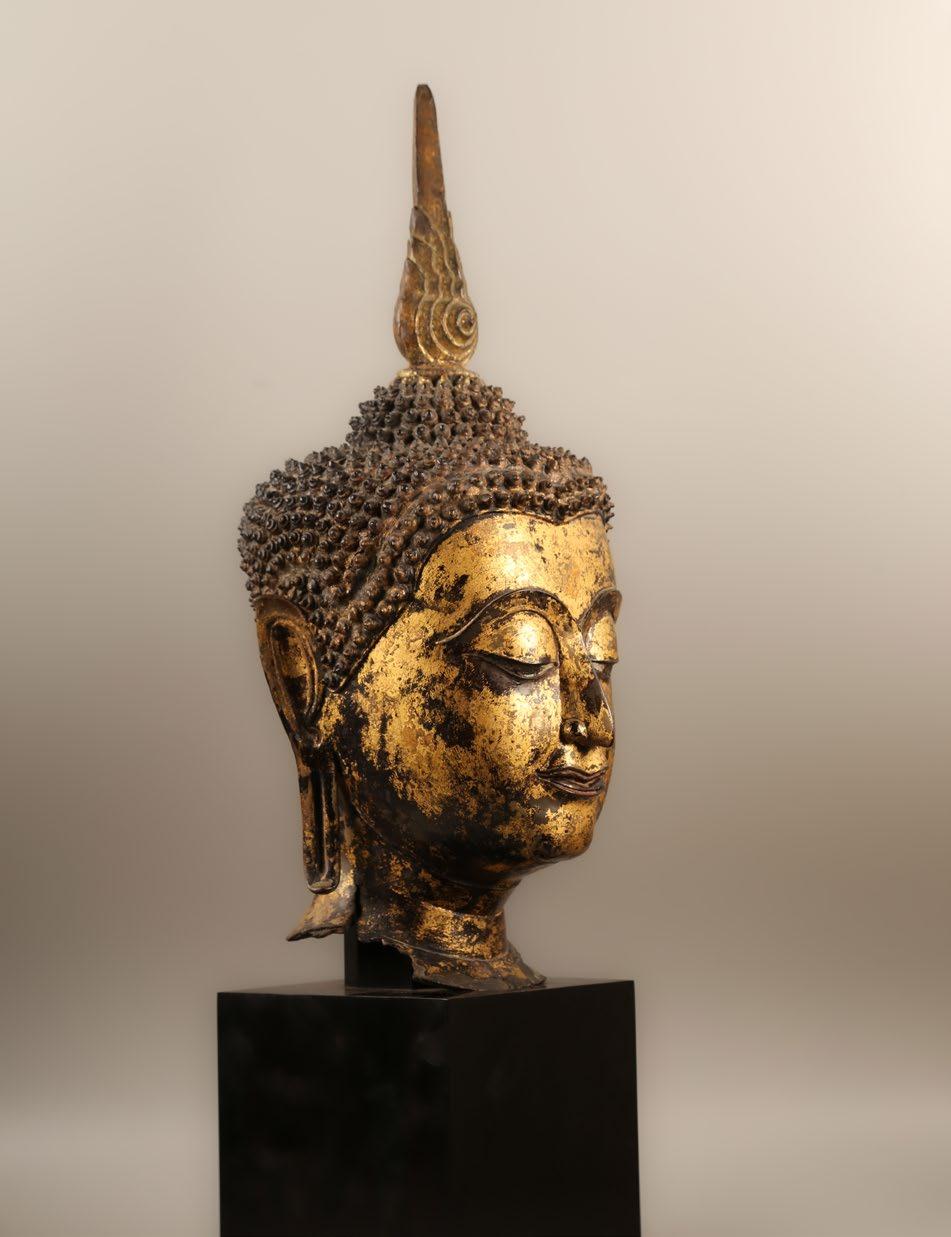
8 - ASIAN ART SOCIETY
Budd H a H ead
thailand
15th-16th century Golden bronze height: 43 cm
provenance: French private collection price on request
Obje C t P R e S ented by:
Christophe hioco
t: +33 (0) 1 53 30 09 65
E: info@galeriehioco.com
W: www.galeriehioco.com
this beautiful sculpture from the Ayutthaya Kingdom period in thailand depicts a Buddha head recognizable by the characteristic elements of the Great Man, or lakṣa a: his serene expression and fine features, the flame rising above the ushnisha. A superb and incredibly wellpreserved golden patina covers almost the entire face of the Buddha. it is also interesting to note the very good preservation of the entire earlobes stretching on either side of his face. his hair is stylized in multiple curls whose relief is notable.
the head is represented here with a calm and peaceful expression. His fine features are typical of the productions of the Ayutthaya period: half-closed eyes and arched eyebrows, full cheeks and a gentle smile stretching across the Buddha's fleshy lips. A certain tendency toward the decorative permeates Ayutthayā art from its inception. this trend became more pronounced over the centuries. The great finesse of the face, the marked relief of the hairstyle, the stylization of the ears with their strong arching and the multiple inlays give this head a particularly amiable and seductive aspect. this decorative aspect will triumph in the Bangkok period after 1782.
april 2023 - 9 01
a d O u B le F lared
Ta K a pe N da NT
ngada tribe
Central Flores
19th century
7,8 cm x 9,4 cm
Weight: 65 gm
price: 8.500 uSd
Obje C t P R e S ented by:
Sue ollemans
M.: + 44 (0) 7775 566 356
E.: sue@ollemans.com
W: www.ollemans.com
10 - ASIAN ART SOCIETY 02
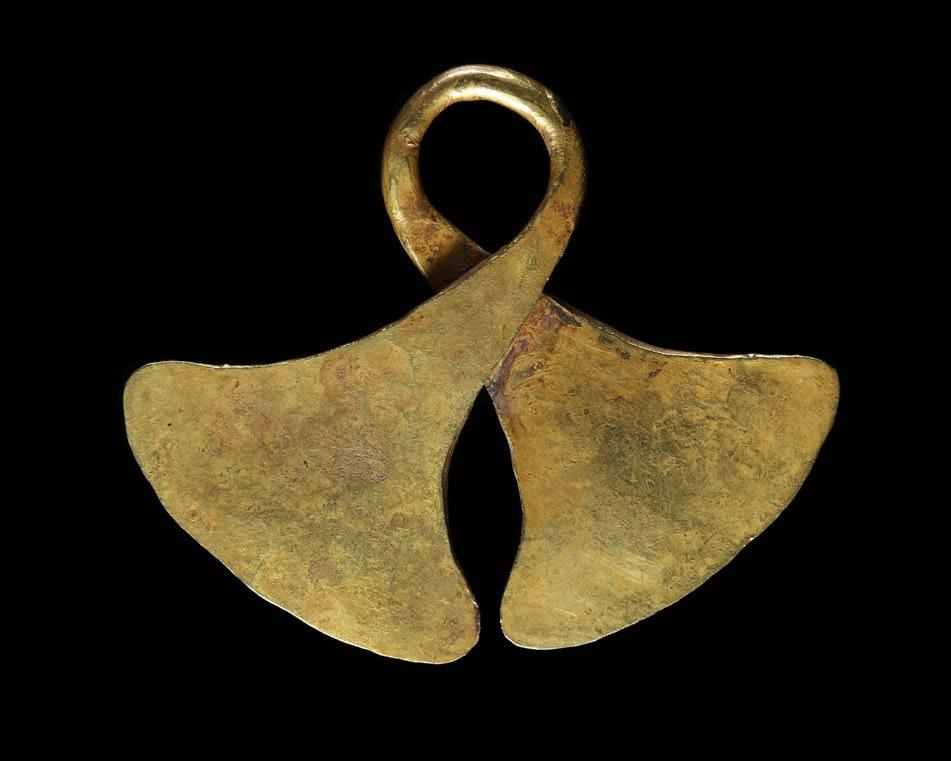
april 2023 - 11
a G O ld e ar p ie C es
W i TH m a N jusri
Singasari
East Java
12th century
2,8 cm x 2,3 cm
Weight: 23,3 grs
provenance:
private collection
price: 6.000 euros
Obje C t P R e S ented by:
Sue ollemans
M.: + 44 (0) 7775 566 356
E.: sue@ollemans.com
W: www.ollemans.com
12 - ASIAN ART SOCIETY 03

april 2023 - 13

14 - ASIAN ART SOCIETY

april 2023 - 15
pair OF sTar Frui T
d rO p e arri NG s
nage tribe
Central Flores
indonesia
19th century
Gold
Length: 10 cm
Weight: 48 grs
price: 3.800 euros
Obje
M.:
16 - ASIAN ART SOCIETY 04
C t P R e S ented
ollemans
by: Sue
566 356
+ 44 (0) 7775
E.: sue@ollemans.com
W: www.ollemans.com
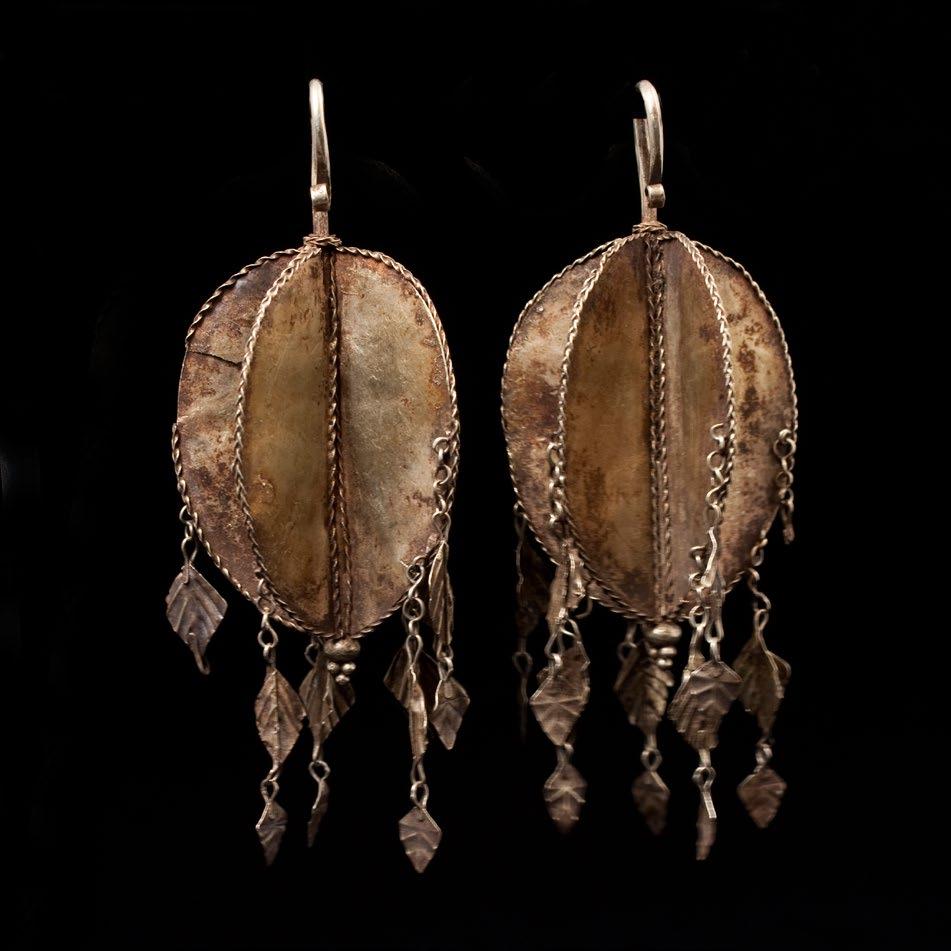
april 2023 - 17
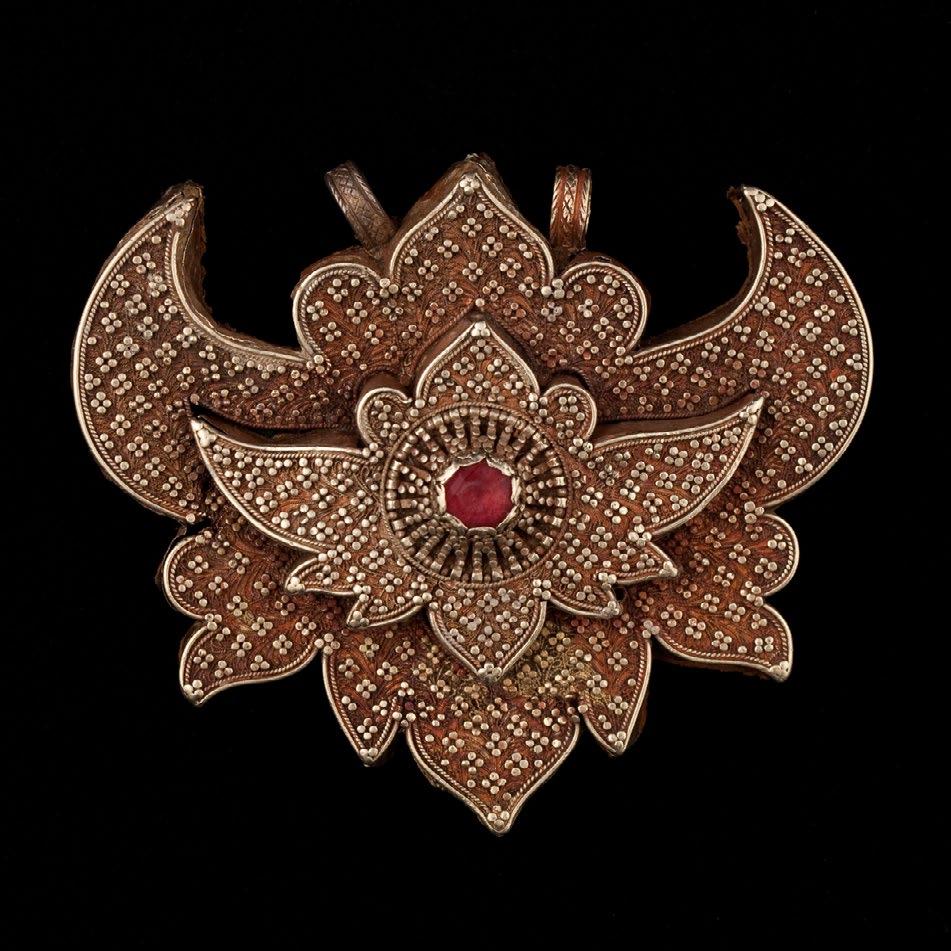
18 - ASIAN ART SOCIETY
7,8
april 2023 - 19 05 a GO ld G ra N ulaT ed pe N da NT Bugis, Sumbawa, indonesia 19/20th century
9,2 cm
cm X
Weight: 61 grams
C t P R e S ented by: Sue ollemans
+ 44 (0) 7775 566 356 E.: sue@ollemans.com
www.ollemans.com
price: 2.500 uSd Obje
M.:
W:
i llus T raT i ON
TO a r asi K apriya
series: Beau T y
OF r ad H a
Bundi
Circa 1680
opaque watercolor heightened with gold on paper
image: 28,9 cm x 14,9 cm
provenance:
Michael Goedhius Colnaghi
oriental, London
Acquired from the above by Francoise et Claude Bourelier, paris, 18 February 1987
Artcurial, paris, 12 May 2015, lot 292 price on request
the present painting is an illustration of the court poet Keshav Das' love poem, the Rasikapriya. Composed in 1591 for his patron, the Raja of Orchha, Das' popular treatise explores the notion of ideal lovers. these narratives feature Radha and Krishna as the nayika and nayak (heroine and hero). This scene, identified as folio number 266, centers the beauty of Radha.
there are evident similarities between this work and the Chunar court Ragamala series, one of the early products of an apparent Mughal influence in Rajasthan (contemporaneous with this Rasikapriya): a vertical format, colorful architectural elements with white roofs, and carefully-executed landscape elements. Such qualities point to the Bundi origin of this painting as it was the next home of the likely-commissioner of the Chunar Ragamala series, Ratan Singh. the expressive facial features differentiate this seventeenth-century Bundi painting from the earlier Mewar paintings Bundi artists imitated, wherein flat figures and bold lines prevailed.
Obje C t P R e S ented by: Kapoor Galleries
M.: + 1 (212) 794-2300
E.: info@kapoors.com
W: www.kapoors.com
20 - ASIAN ART SOCIETY 06


i llus T raT i ON TO TH e d evi
m a H aT mya: Kali
Wi TH dra W s F rO m
v is HN u
Jaipur Circa 1800 opaque watercolor heightened with gold on paper
image: 28,9 cm x 19,1 cm
Folio: 29,8 cm x 19,7 cm
provenance:
private French collection price on request
Obje C t P R e S ented by: Kapoor Galleries
M.: + 1 (212) 794-2300
E.: info@kapoors.com
W: www.kapoors.com
The present scene depicts the first episode of the Devi Mahatmya during the time of pralaya, the period between the cyclical destruction and creation of the universe when the primordial ocean is all that exists. Vishnu is depicted in deep sleep amongst the cosmic waters while Brahma prepares to create the next universal cycle. Brahma's efforts, however, are interrupted by two demons who emerge to kill him. Alarmed, he attempts to awaken Vishnu to slay the demons, singing a hymn of praise. Brahma sings to the great goddess Mahamaya, the personification of Vishnu's sleep, and asks her to release him from her spell. As devi proceeds to retreat from Vishnu's body she appears before Brahma. Vishnu then awakens and slays the demons, thereby acting as Devi's instrument in restoring cosmic order.
here, devi appears in her form as the ten-headed dasa Mahavidya Mahakali. this form of the goddess is relatively rare in the indian painting tradition, as she is more commonly portrayed in her one-headed, fourarmed image, trampling Shiva. however, the present form shares many iconographic attributes with the more common form. Clad in a garland of severed heads and skirt of dismembered arms, Kali holds items representing the powers of each of the gods in her ten hands: a severed head, trident, bow, mace, conch, sword, and chakra. her outstretched tongues, bared teeth, long unruly hair, large nimbus and strong stance convey her fierceness. Below, Vishnu reclines, and Brahma emerges from Vishnu's navel on a lotus, flanked by the demons Madhu and Kaitabha. Fine lines of water and lotuses comprise the cosmic ocean, while a horizon of foliage bisects the background with a pale blue-grey sky above. this partitioning of the background reinforces the hierarchical scale of the painting and thus emphasizes Kali's great power.
april 2023 - 23
07
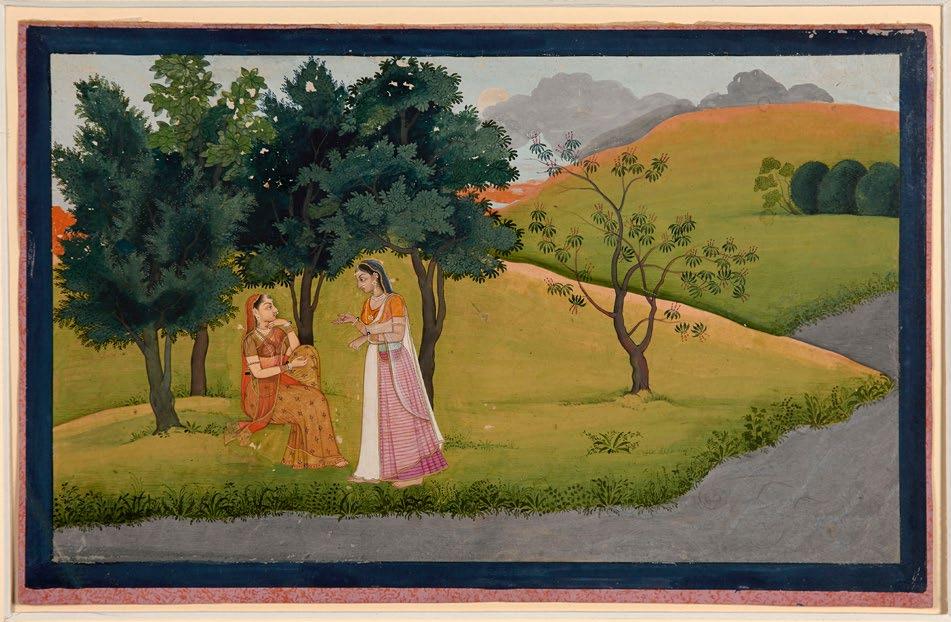
24 - ASIAN ART SOCIETY
l ea F F rO m a Gi Ta
G Ovi N da series:
r ad H a v e NT s H er Frus T raT i ON s
First generation after Nainsukh Kangra
Circa 1775 - 1780
opaque watercolor heightened with gold on paper image: 17 cm x 27 cm
provenance:
the Collection of Françoise et Claude Bourelier
price on request
Obje C t P R e S ented by: Kapoor Galleries
M.: + 1 (212) 794-2300
E.: info@kapoors.com
W: www.kapoors.com
Sheltered within the verdant foliage of a grove of vakula and tamala trees, Radha appears garbed in a semitransparent orhani composed of mute colors. the ghaghra skirt around her waist cascades into gentle folds and a brief bodice exposes her bare midriff. Paramount attention to detail can be seen in the diaphanous materials of her layered garments as well as her intricate jewelry. Copious but not gaudy, she is adorned with gold, emeralds, and pearls. Equal attention is paid to the rendering of her confidant, who stands beside her on the Yamuna river bank as they discuss her beloved, Krishna.
Radha's face, as well as that of her companion, is of “porcelain delicacy,” rounded but in such a matter as to not be “fleshy.” Her features are pronounced and sharp, her lips small (an attractive quality of the time), eyebrows gently arched, eyes gazing soft yet discerningly. “Radha's body is young and lissome; the limbs tender, the breasts full, hands and feet delicate.” (Goswamy & Fischer, pg 315). Her stance is relaxed and natural, a reflection of her sweet countenance.
the setting is established with meticulous care. the small rises of the terrain and undulating ground all give a feeling of vast space and openness, but in such a way that attention is not drawn to wander from the foreground in which Radha and her companion are engaged in discussion. the delicacy and naturalism apparent in the rendering of nature imbues the scene with a fullness that conveys the hand of a master artist.
this folio comes from a Gita Govinda series that describes the courtship of Krishna and Radha as told by the poet Jayadeva. through Krishna and Radha, Jayadeva evokes the fullness of love, filled with passion and longing as well as pride and jealousy. Serving as an allegory for the soul's longing to unite with the divine, Krishna and Radha's love story is at its heart “the tempestuous process of emotional – and spiritual struggle – for grace." D. Mason, Intimate Worlds, Philadelphia, 2001, p. 192. For other paintings from this series see Joseph M. dye iii, The Arts of India, Virginia, 2001, no. 151, p. 350; D. Mason, Intimate Worlds, Philadelphia, 2001, no. 82 & 83, pp. 192-194; W. G. Archer, Indian Paintings from the Punjab Hills, vol. II, 1972, nos. 33(i) – 33(vii); B. N. Goswamy and E. Fischer, Pahari Masters, Zurich, 1992, nos. 130 – 137, pp. 320 – 331.
april 2023 - 25 08
GilT Budd H a
Sino-tibetan
17th century
height: 12,8 cm
Weight: 968 grs
price on request
Obje C t P R e S ented by:
Brandt Asian Art
M: +44 (0)7774 989 661
E: brandt@nildram.co.uk
W: www.brandtasianart.com
A good Sino–Tibetan gilt bronze Buddha, seated in dhyanasana, upon a double lotus throne, the left hand in dynana mudra, the right in karana, draped in monks' robes, covering one shoulder, the chest bare save from one emblem wan. the full face with bud lips and heavily lidded eyes, below an urna.
26 - ASIAN ART SOCIETY 09

april 2023 - 27
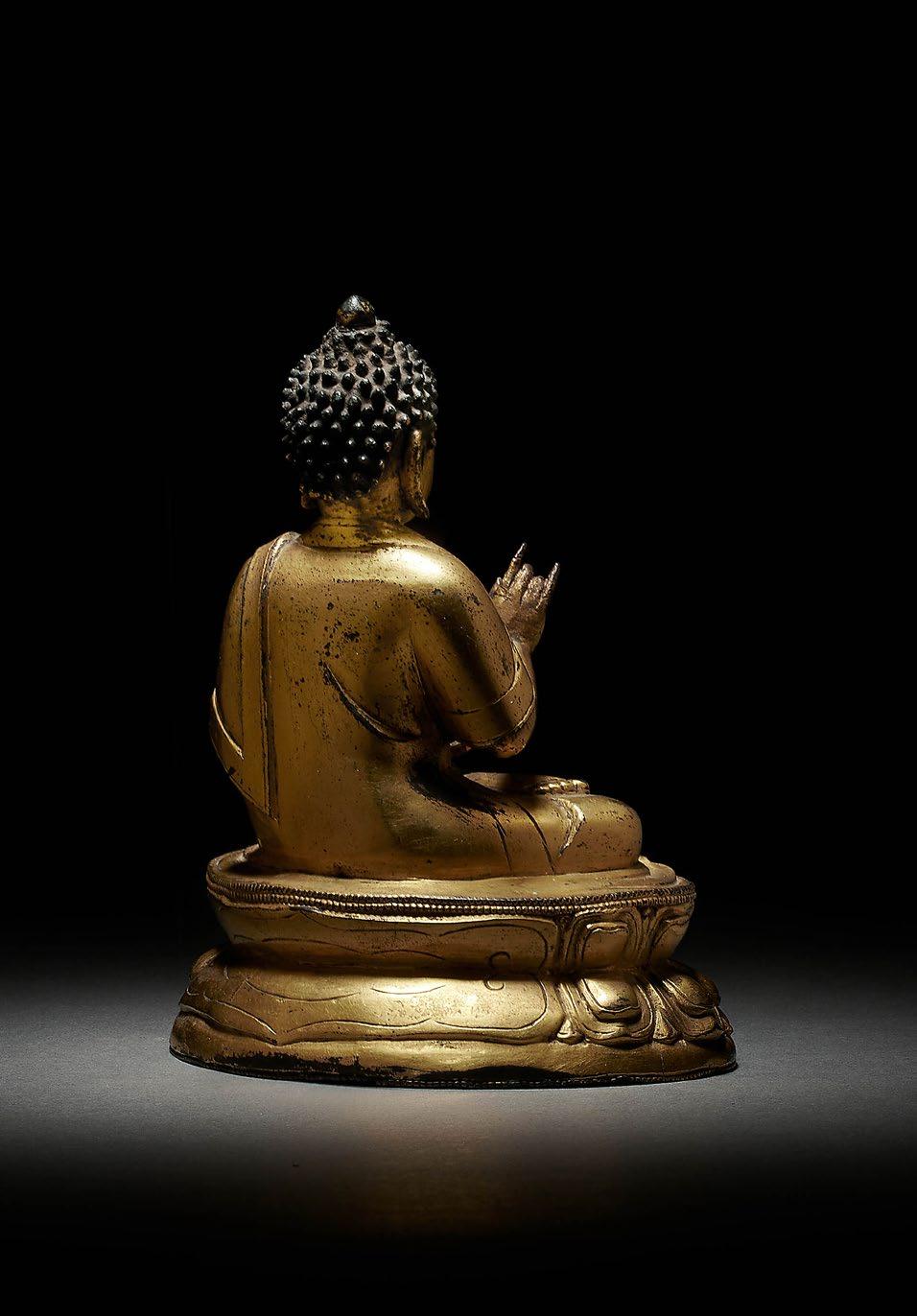
28 - ASIAN ART SOCIETY
april 2023 - 29
a ya K leaTH er
s TO ra G e CH es T
W i TH COver
tibet 1900
43 cm x 62 cm x 32 cm
provenance:
German private collection, assembled in the 1980s.
price on request
Obje C t P R e S ented by:
Farah Massart
M.:+32 495 289 100
E.: art@famarte.be
W: www.famarte.com
the rectangular yak leather chest is embellished with an impressive silver and gilded central medallion containing flat relief decoration of endless knots and foliate design. A beautiful metal lock and key complete the set. the eight corners are decorated with metal mounts. the chest and cover are decorated with metal twin loose ring handle, leather handles and strapwork. this kind of tibetan chests were used as storage boxes in homes or monasteries, or more probably when travelling.
30 - ASIAN ART SOCIETY 10
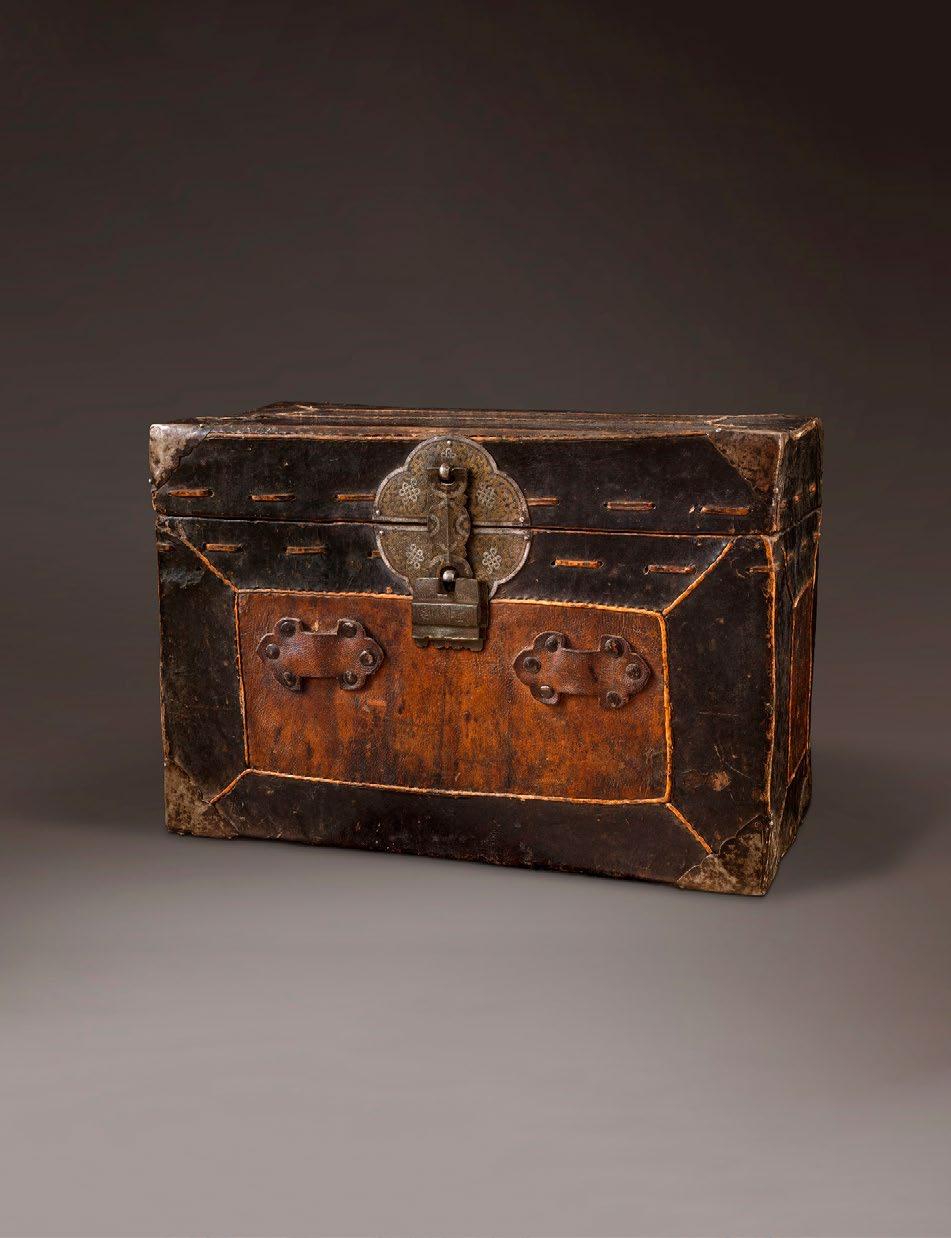
april 2023 - 31
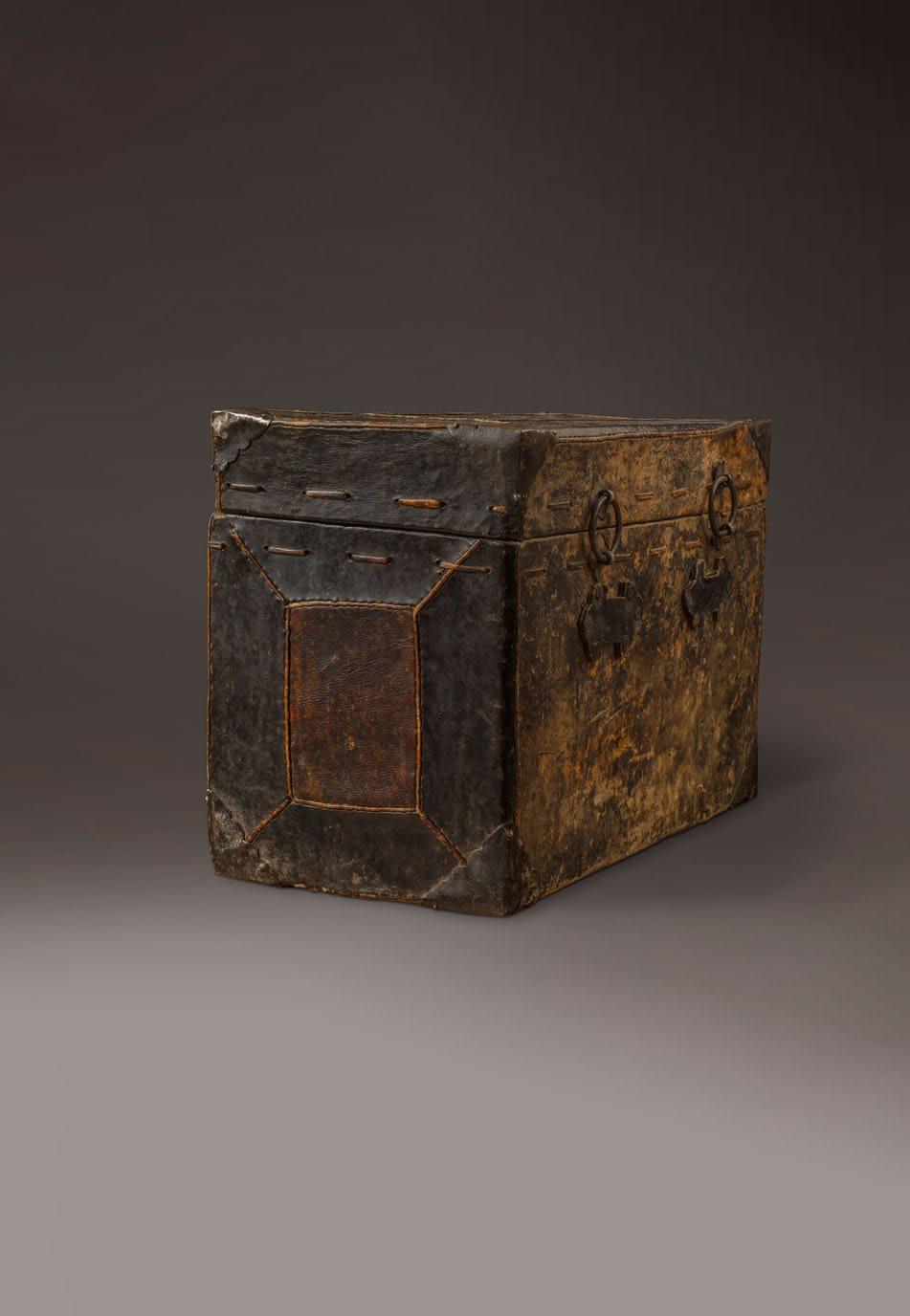
32 - ASIAN ART SOCIETY
april 2023 - 33
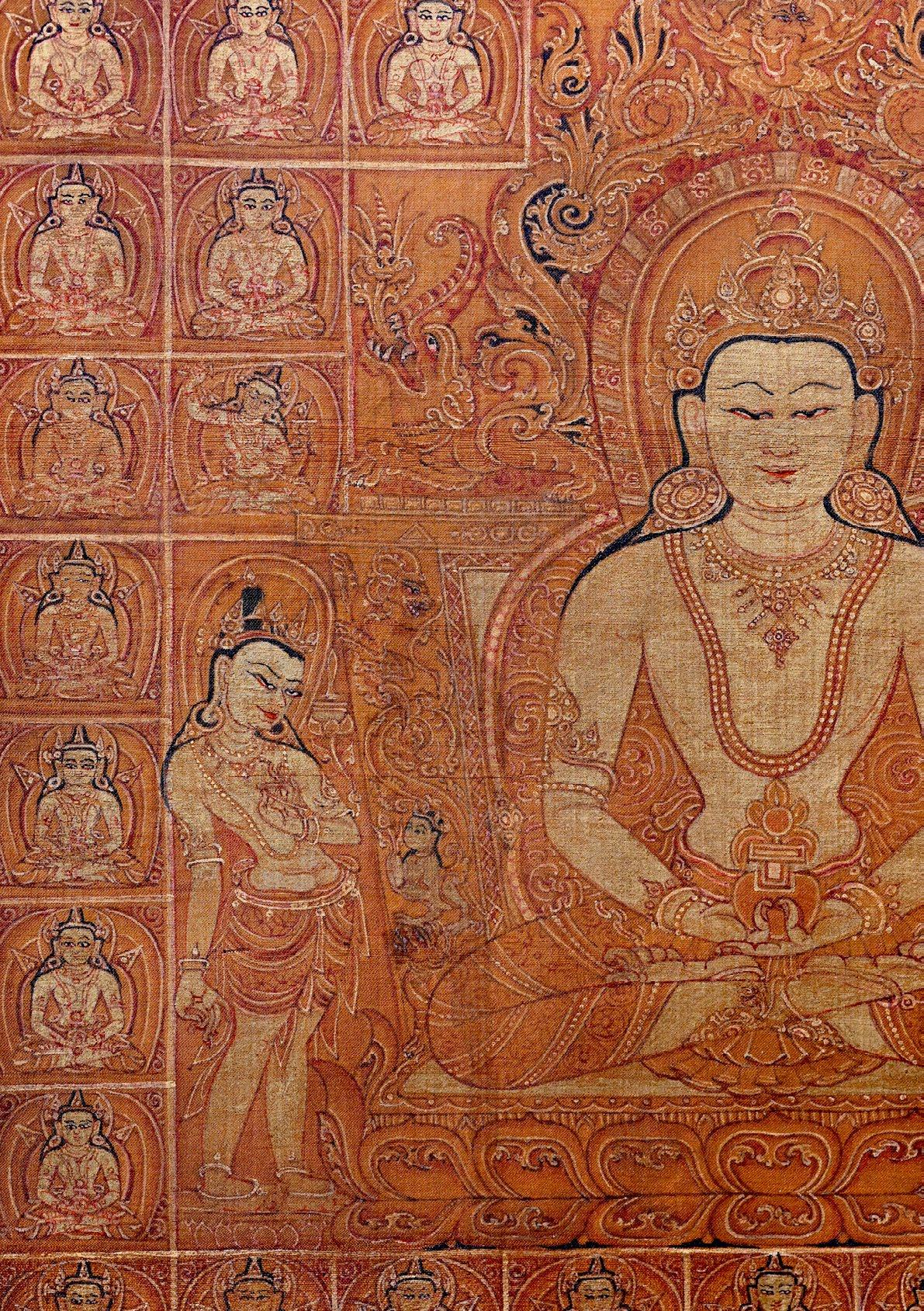
sC rO ll pai NT i NG (Ti B: Thang ka or s k u T hang) of AmitAyūs (t ib: Tshe dpag med, prONO u NC ed:
Tsépa G may) T H e
d ei T y OF lONG-l i F e.
tibet
1400 to 1450 Ad
Coloured pigment and gold on red silk 40 cm x 26 cm price on request
Amitayūs is flanked by two bodhisattva figures who act as interlocutors and respond directly to questions put by the person seeking life-lengthening to Amitayūs himself. Amitayūs's eyes show how masterfully the artist has depicted him looking ‘inward' in meditation – apparently totally separated from worldly matters but with his eyes just open enough to see humanity and therefore help suffering sentient beings. He wears elaborate royal ornaments to show his great importance as the celestial manifestation of Amitābha and his royal robes are versions of indian high quality garments as understood by a tibetan artist.
his elaborate throne is surmounted by a Garuda bird with outstretched wings and although i am unable to see from this picture, Garuda should be holding a snake in his beak. This represents Garuda's power to protect the Buddhas and their disciples from the poisons levelled against them by malicious spirits as well as protecting from the poison of ignorance.
The symbol which represents Amitayūs's ability to bestow long-life is the elaborate vase he holds in his lap. this vase is said to contain the elixir of long-life and this power is symbolized in the sprouting plants seen emerging from it. in a manner of speaking this vase has some aspects in common with the European concept of the Green Man.
Obje C t P R e S ented by: hollywood Galleries
t.: +852 2559 8688
+852 2541 6338
E.: hollywoodgalleries@gmail.com
W: www.hollywood-galleries.com
We can note on each of the central figure's knees, a small kinnara figure facing outwards. These kinnara are celestial musicians and they have bird-like legs because they are associated with the great deity Garuda, himself a bird. The music they play reflects the state of perfection that Amitayūs represent.
At head height to Amitayūs's right hand side is the deity of Transcendental Wisdom, Mañjuśrī who holds a sword above his head. the sword represents the wisdom which cuts ignorance free from wisdom revealing wisdom's ultimately pure state.
april 2023 - 35
11
SOLD
To each side of Amitayūs's head along the throne top, are seen two makaras. these are mythical sea monsters who have been given the task of protecting doorways and other sacred precincts in Buddhism. in Buddhist myth they resent people attempting to harvest ocean pearls and such items which belong to them and they can take terrible revenge by causing shipwrecks and drownings.
There are 73 images of Amitayūs in total including the central figure. I cannot imagine a reason for such a specific number but suggest that it might represent the age of the person for whom the long-life ceremony was intended and that there was a general hope that the ritual would lengthen his life-span.
We may note the presence of another very powerful long-life deity, namely the White form of the goddess Tārā who is located at the central figure's left side at head height.
At the very top of the painting in the centre we can see Vajradhara, crossing arms holding vajra and bell. Vajradhara is an important deity popular in the 13-15th century seen in Kagyu school paintings.
The horizontal inscription is in a different type of tibetan script and reads,
Brag phug tsan dan dgon
A rough provisional translation would read,
‘(At) the Rocky Cave of Sandalwood Monastery.'
36 - ASIAN ART SOCIETY

april 2023 - 37
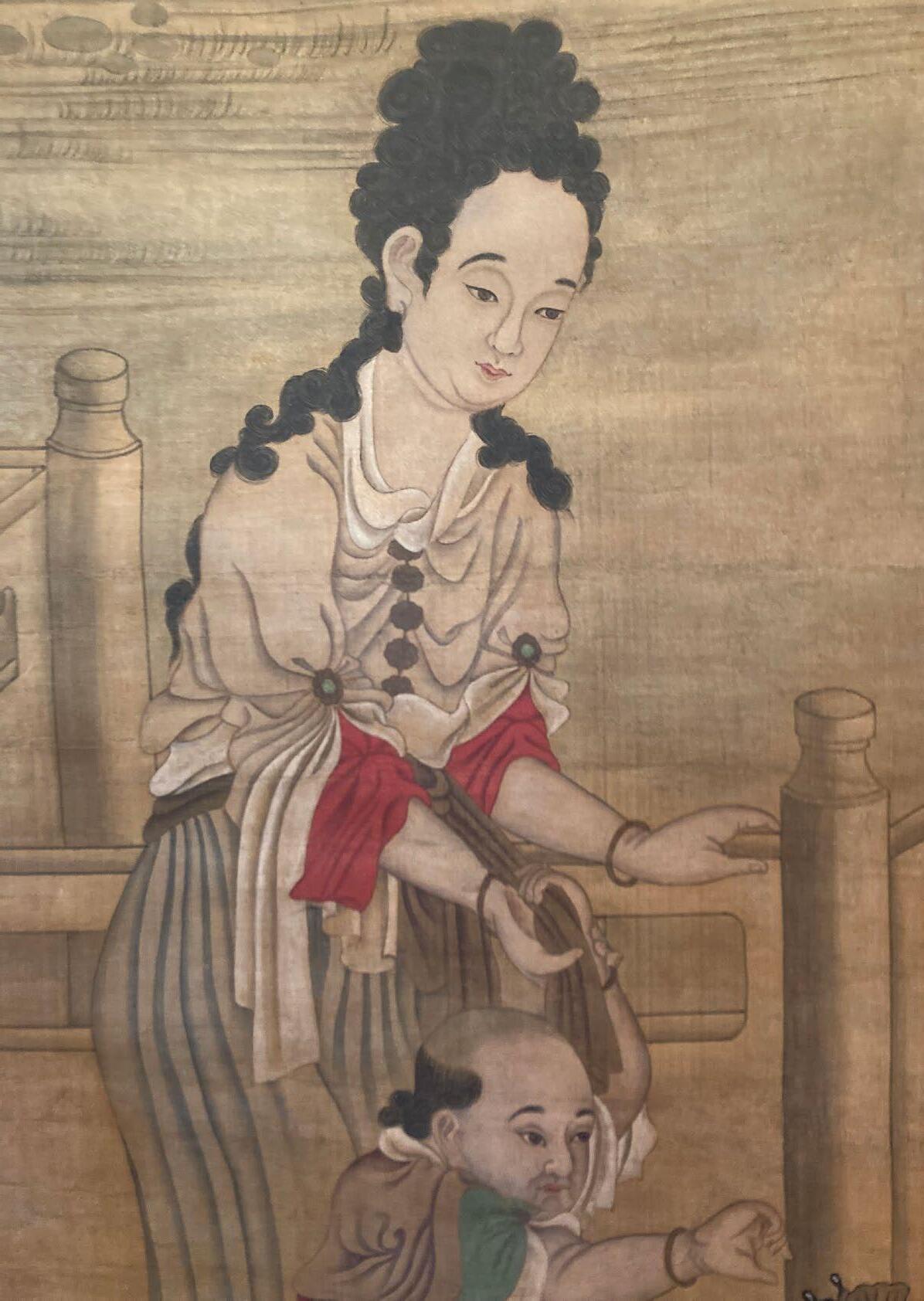
a C H i N ese pai NT i NG
OF a e urO pea N
W O ma N a N d H er
C H ild
China
Qing dynasty (1644-1911)
18th century
ink and color on silk
height: 157,5 cm
Width: 52 cm
provenance: Jorge Welsh Works of Art, Lisbon
publication:
Cf. A very similar painting, larger in size, was published in: eds. Ann Jackson and Amin Jaffer, Encounters: The Meeting of Asia and Europe, 1500 – 1800 Victoria and Albert Museum, London, 2004, p. 214, left illustration the whereabouts of the abovereferenced published painting, formerly with Jorge Welsh, are unknown
Condition: Conserved and remounted in 2022 by Studio Sogendo, Alameda, California, uSA price on request
Obje C t P R e S ented by:
Alan Kennedy
M: +1 646 753-4938
E: kennedyalan@hotmail.com
W: www.alankennedyasianart.com
april 2023 - 39 12

40 - ASIAN ART SOCIETY
A European woman, as imagined by a Chinese artist, stands in front of a fence, with her left hand on the top rail of the fence. Both of her hands are large, and the her right one holds the wrist of a male child and a sash that wraps around her waist. her curly hair (a wig?) is piled high atop her head, and cascades over her shoulders and down her back. She displays a large ear with an earring, and her eye sockets and nose are large by Chinese standards. her jewelry consists of brooches at her upper sleeves, simple bracelets at her wrists, and the aforementioned earring.
the little boy reaches out with his right arm towards a butterfly fluttering nearby. His head is shaved at the top, and gathered in small buns at the back of his neck. The boy's face is not particularly child-like, and he has a large ear, eye sockets and nose like his mother.
European women were not known to have been in China prior to the mid-19th century, therefore this female depiction could not be a portrait of an actual person. it is likely based on European prints that would have been accessible in China, filtered through the imagination of a Chinese artist.
A very similar painting, published in: eds. Ann Jackson and Amin Jaffer, Encounters: The Meeting of Asia and Europe, 1500 – 1800. Victoria and Albert Museum, London, 2004, p. 214,

april 2023 - 41
COCON u T B OW l
China
18th century
15 cm
price on request
Obje C t P R e S ented by:
Brandt Asian Art
M: +44 (0)7774 989 661
E: brandt@nildram.co.uk
W: www.brandtasianart.com
A two handled coconut bowl carved to exterior with a broad band of bats and shou symbols, below a narrow section of cross-hatch pattern, some red pigment remaining, the interior plain.
42 - ASIAN ART SOCIETY 13

april 2023 - 43
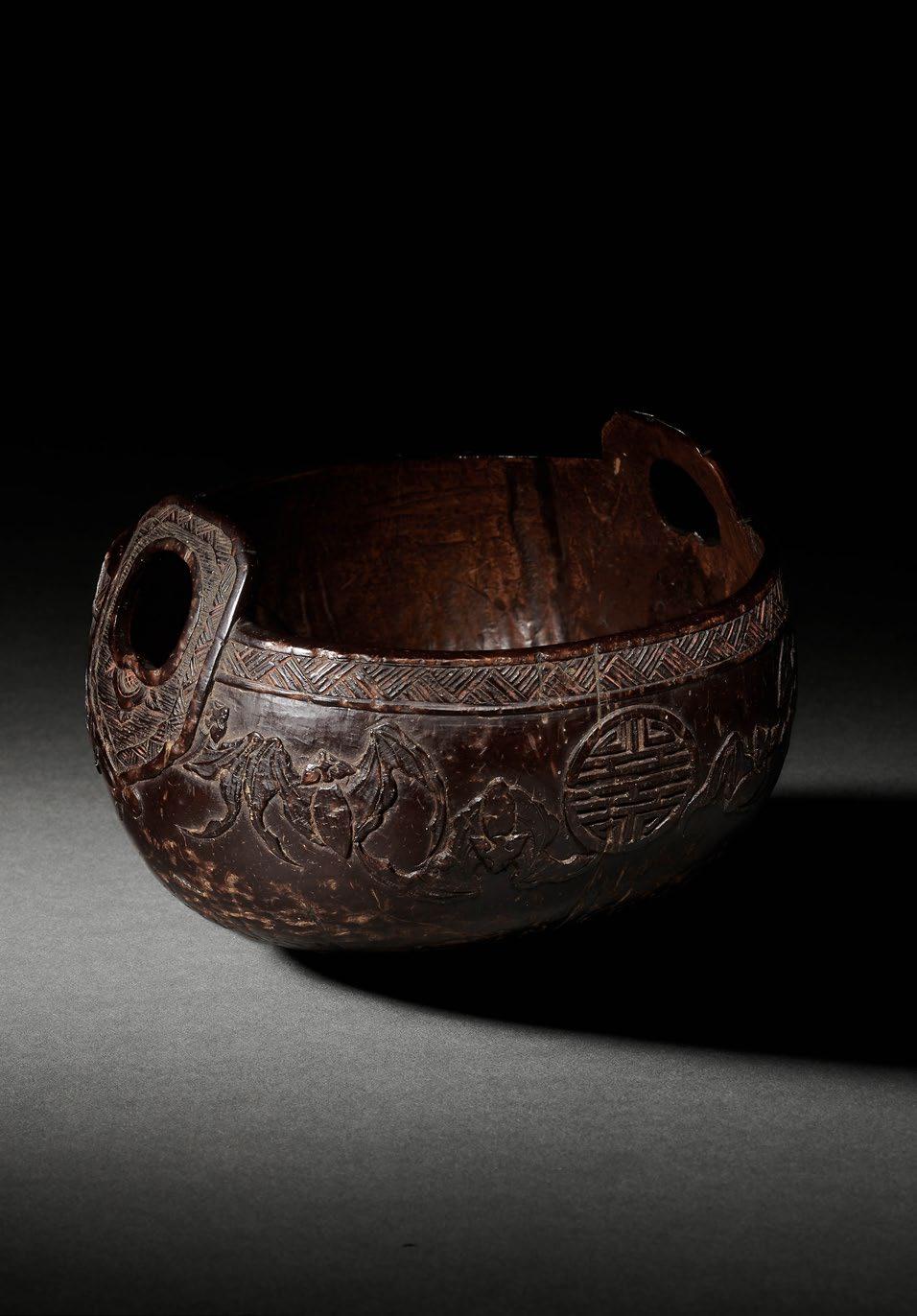
44 - ASIAN ART SOCIETY
april 2023 - 45
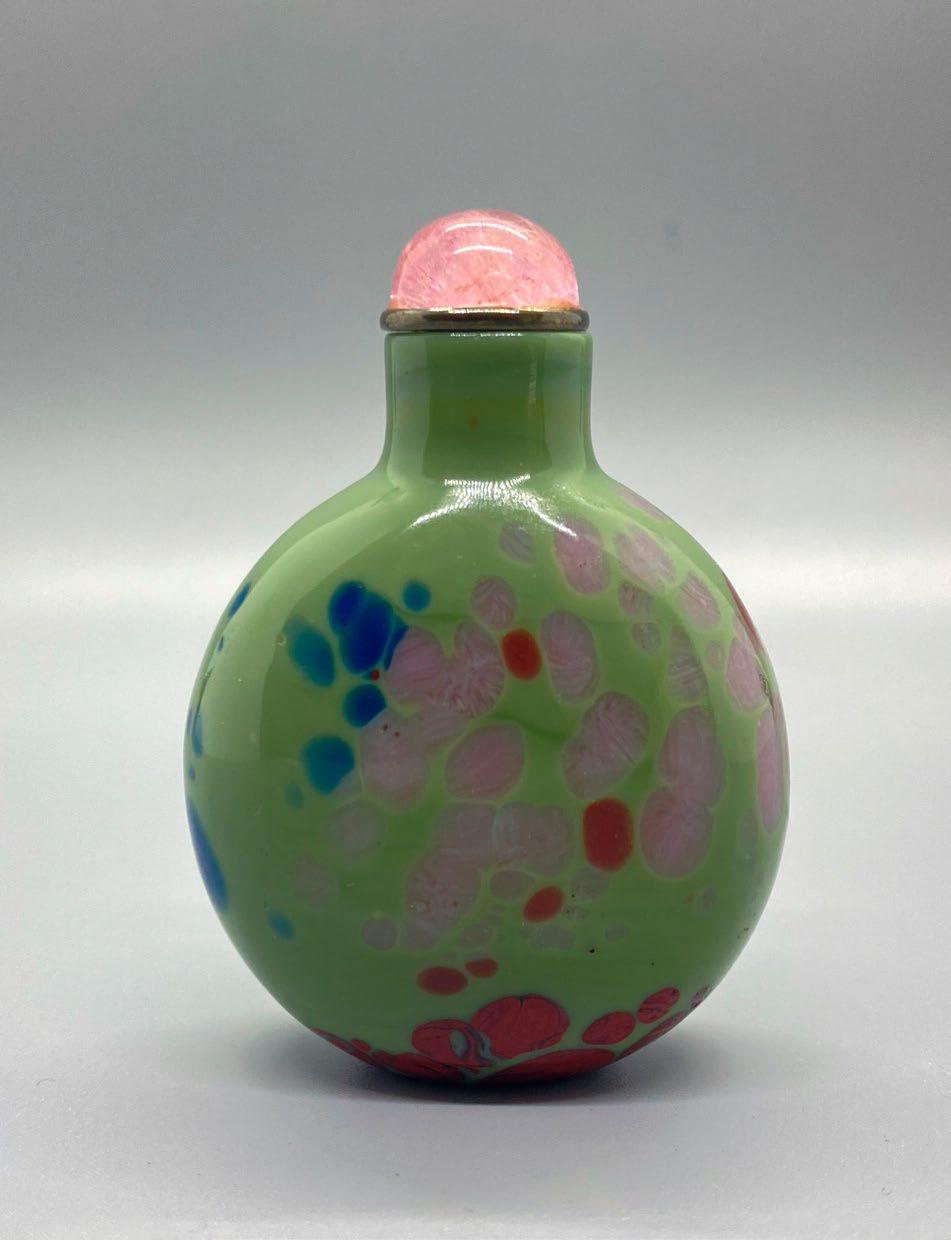
46 - ASIAN ART SOCIETY
s N u FF BOTT le
China
1750-1800
Glass height: 2” (5,1 cm) (excluding the stopper)
provenance:
Robert hall, London
Bob and Molly hsieh, Md. Collection
A private Chicago, iL. Collection price on request
A glass snuff bottle, of rounded form, with a cylindrical neck, with a recessed oval footrim, the olive-green glass with irregular splashes of blue, red and pink forming an appealing abstract design.
Attributed to Beijing
Obje C t P R e S ented by:
Clare Chu Asian Art LLC
M.:+ 1.310.980.4084
E.: clarechuasianart@gmail.com
Since the publication of the palace Archives in both Chinese and English, the knowledge that is at the fingertips of today's researchers has grown enormously in terms of the activities of the imperial Workshops and their output. By deduction, the Archives also give clues to add to our grasp of what was happening outside the Palace. However, it is still not clear when Beijing's commercial glass production began. Given that Beijing was the capital of the last three dynasties and that glass production was a centralized process, it is likely that it commenced relatively early and from the seventeenth century onwards, Beijing became the center of glassmaking in China. Boshan in Shandong province was another center, already known as a "glass city". Glass crafted in Beijing was termed liao qi meaning objects fashioned from glass made in Shandong where Boshan is situated, while the words guan liao referred to glass from the Imperial workshops or "official glass". Liao qi was the name given by the glass-makers of Boshan to glass that was subsequently used in Beijing and being transported into the area as ingots or blocks, which were then melted down and re-worked to make the finished product. During the reign of Qianlong, when large amounts of glass began to appear at Court and in the homes of the wealthy, there was keen competition between three studios in Beijing for the production of glass objects including snuff bottles - the Xin family, the Le family and the Yuan family. unfortunately, it is not known which families made which snuff bottles, although some writings refer to overlay glass being produced by all three. A bottle such as this one could have been manufactured as part of the commercial production rather than from within the palace. despite its contemporary look, it is likely to be eighteenth century and illustrates clearly what the glass makers of the time could produce.
april 2023 - 47 14

48 - ASIAN ART SOCIETY
s N u FF BOTT le
China
1780-1850
porcelain
height: 1 1/2” (4 cm)
(excluding the stopper)
provenance:
A private East Coast, uSA Collection price on request
A porcelain snuff jarlet, of squat cylindrical form, with a slightly waisted neck and with a circular footrim, decorated in underglaze blue and white, with two foliate panels, each with a scene of bronze vessels, planters and a scholars' stand, surrounded by a design of Buddhist swastikas, the base encircled by a band of leaves, the shoulders with a band of scrolling flowers, with its original matching stopper decorated with a blossoming flower.
Attributed to Jingdezhen
Hugh Moss states that snuff ‘pots,' squat cylindrical forms with very wide mouths, were popular in the nineteenth century when it became fashionable to put flowers in the mouth of a bottle overnight to scent the snuff. These are referred to in the commentaries to the Yonglu xianjie of ceramics, where a number are known, all of the daoguang period or later. however the Qianlong Archives of the Zaobanchu, the imperial Household Department, refer to both snuff bottles and snuff jars when they sent their manufacturing orders to the glass workshops, indicating that these ‘jarlets' were made as early as the mid-Qianlong period. Whilst they were therefore made in both glass and, subsequently, porcelain, they are rare in other materials, though a very few examples exist in agate.
Obje C t P R e S ented by:
Clare Chu Asian Art LLC
M.:+ 1.310.980.4084
E.: clarechuasianart@gmail.com
april 2023 - 49 15

50 - ASIAN ART SOCIETY
s N u FF BOTT le
China
1780-1850
Jadeite
height: 2 1/16” (5, 2 cm) (excluding the stopper) price on request Obje
A jadeite snuff bottle, of bulbous, ovoid form, with a cylindrical neck and a flat oval base, very well-hollowed, the apple-green stone suffused with icy-white patches, known as ‘pine trees in the snow.'
it was the French chemist Augustine Alexis damour, who first brought into the West the idea that under the generic label of jade were two distinct minerals: nephrite and jadeite. in 1860 Comte Klaczkowsky was present at the sacking of the Summer palace in Beijing, and he returned to paris with some unusual looking emerald green jades that he had looted. the ceramics expert Albert Jules Jacquemart pronounced them to be "jade imperial," reminding him of the green enamel color present on the imperial Chinese porcelains that he had seen. damour, a couple of years later, in 1863, realized that it was not nephrite (a term coined by the Germans in 1789) and renamed it jadeite, as he considered it to resemble the piedra de ijada, "the stone of the loin" of Aztec and Maya carvings. It was towards the end of the eighteenth century that good quality jadeite was imported into China in any decent quantity. initially the Chinese traders brought it directly across the Burmese borders, although after 1780 supplies became dependable via regular traffic through Guangzhou. the Qianlong Emperor, fond as he was of nephrite, loved the brilliant greens in jadeite and paid dearly to obtain it.
april 2023 - 51 16
C t P R e S ented by:
Chu Asian Art LLC
1.310.980.4084
clarechuasianart@gmail.com
Clare
M.:+
E.:

52 - ASIAN ART SOCIETY
Fres CO W i TH F emale aTT e N da NT s
China
Late Yuan-early Ming dynasty 14-15th century
Length: 46,5 cm
Width: 59 cm, mounted on a stand provenance:
private French collection, acquired in 1998
price on request
Obje C t P R e S ented by:
Rasti Fine Art Ltd.
M.:+852 2415 1888
E.: gallery@rastifineart.com
W: www.rastifineart.com
A polychrome fresco fragment of rectangular form, painted with six female attendants elaborately dressed in long flowing robes and holding long poles, a scholar holding a hu with an attendant in the foreground, all amongst clouds
april 2023 - 53 17
i vO ry Gua N yi N
China Ming dynasty
16-17th century height: 8,3 cm
provenance:
private European collection
uK CitES export no. 476204/01 and hong Kong permits price on request
An ivory model of seated Guanyin, wearing long flowing robes and cowl, the hands held in front holding a pearl through the robes, the ivory of rich caramel tones
For a similar small, seated model of Guanyin see Spink & Son Ltd., Ivories of China and the East, no. 14b; and for another of a seated Guanyin and child see Spink & Son Ltd., The Minor Arts of China IV, p. 38, no. 41.
Obje C t P R e S ented by:
Rasti Fine Art Ltd.
M.:+852 2415 1888
E.: gallery@rastifineart.com
W: www.rastifineart.com
54 - ASIAN ART SOCIETY 18
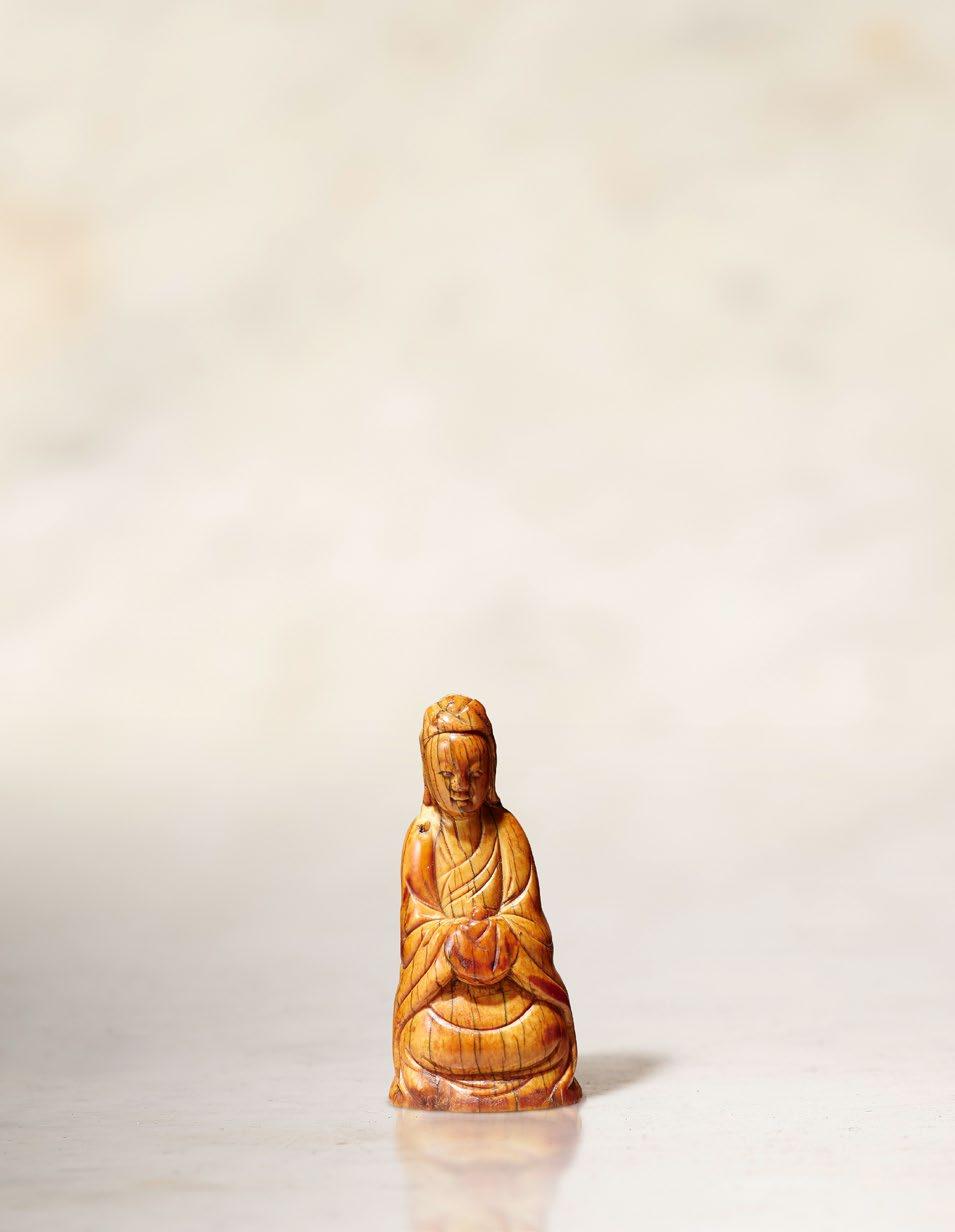
april 2023 - 55
s aT suma CH aire (T ea C addy)
Japan
Early Edo-period (1603-1868)
height: 9,4 cm
price on request
Obje C t P R e S ented by:
Kitsune Japanese Art
M.: +32 476 87 85 69
E.: arie.vos@kitsune.be
W.:www.kitsunegaroo.com
Satsuma-yaki was produced on the island of Kyushu, Kagoshima prefecture, Japan. The first kilns were founded by the Koreans around 1599. in 1661, 25 potters were active in 4 different kilns. Typical for early Satsuma chaire is a base without itokiri string marks having a flat / mottled effect. Another typical feature seen on early Satsuma chaire is the short koshiki (neck). Most Satsuma chadogu (items for the tea ceremony) from the 17th cetury are of cylindrical or ovoid shape. the example here is cylindrical.
note that during early Edo-period, cha-ire were large anough to hold sufficient tea for service of five or more guests (Edo period writings argue that 10 guests were entertained at early tea gatherings). Since this chaire is of large size, it confirms an old label dating it to the early Edo-period.
56 - ASIAN ART SOCIETY 19

april 2023 - 57

58 - ASIAN ART SOCIETY
An exquisite enamel box decorated overall with dragon flies in a kaleidoscope of colours, with silver mounts. inlaid Ando mark.
Cl O is ONN é B Ox
Japan
Early 20th century 9 cm x 10 cm
price on request
Obje C t P R e S ented by:
Brandt Asian Art
M: +44 (0)7774 989 661
E: brandt@nildram.co.uk
W: www.brandtasianart.com
april 2023 - 59 20
60 - ASIAN ART SOCIETY
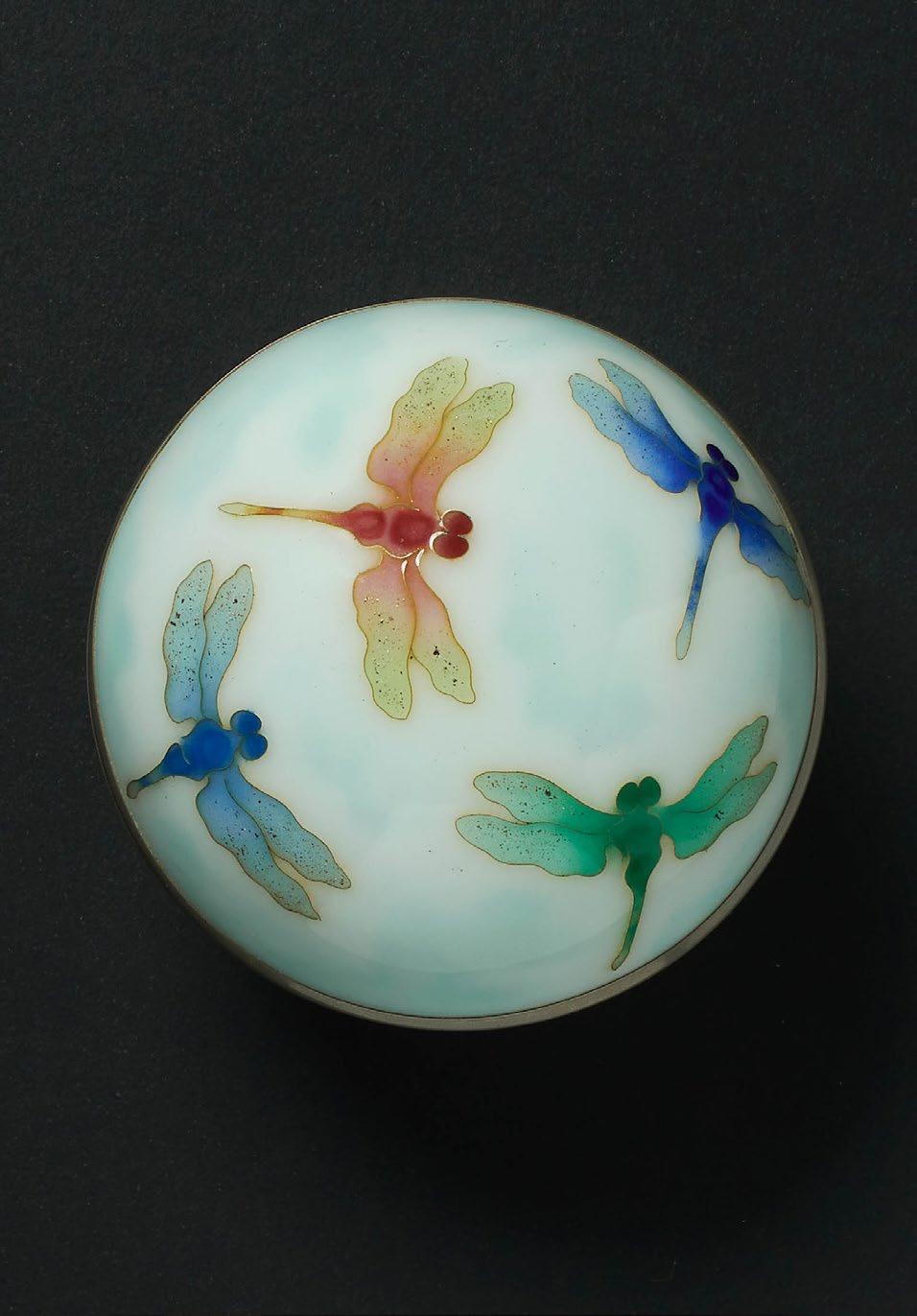
april 2023 - 61
j i GOK u d ayu (Hell CO ur T esa N) a N d s K ull
By Seppo. the artist might have been associated with tsukioka Settei, tsukioka Sessai or tsukioka Sekkei, Osaka. Signed as "Seppo utsusu" (Painted by Seppo), Seals “Gyokuin no in” and one more (unread).
Japan
Silk, textile mount and hanging, the Jikusaki is in bone
189,5 cm x 54 cm (overall
98 cm x 40 cm (painting price on request
Obje C t P R e S ented by:
Galerie Mingei
M: +33 (0)6 09 76 60 68
E: mingei.arts.gallery@gmail.com
W: www.mingei.gallery
(1865-1928) Akabane Seppo studied painting under ozaki Setto (nanga style painting, Kyoto) and hashimoto Gaho (tokyo) and at what is now called the tokyo university of Fine Art. however it is unlikely that this painting is by him. this Seppo who painted this Jigokudayu (hell Courtesan) might have studied under tsukioka Settei, tsukioka Sessai or tsukioka Sekkei, osaka.
the Jigokudayu 地獄大夫 (hell Courtesan) is depicted proudly standing attired in her vivid kimono. the kimono is decorated with images from hell; Enma (King of Hell) and Jizo (the guardian of children, travellers and the underworld), oni demos and people tormented in hell, a carriage on fire (“Kataku no hito 火宅に人” parable) etc. the hair style of the courtesan is known as hyogo-mage 兵庫髷which is fashionably adorned with luxurious and very costly tortoise-shell (Bekko) hair pins.
62 - ASIAN ART SOCIETY 21
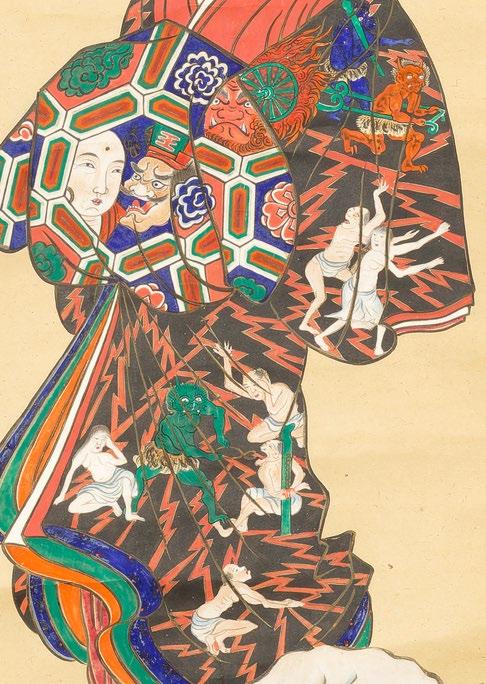
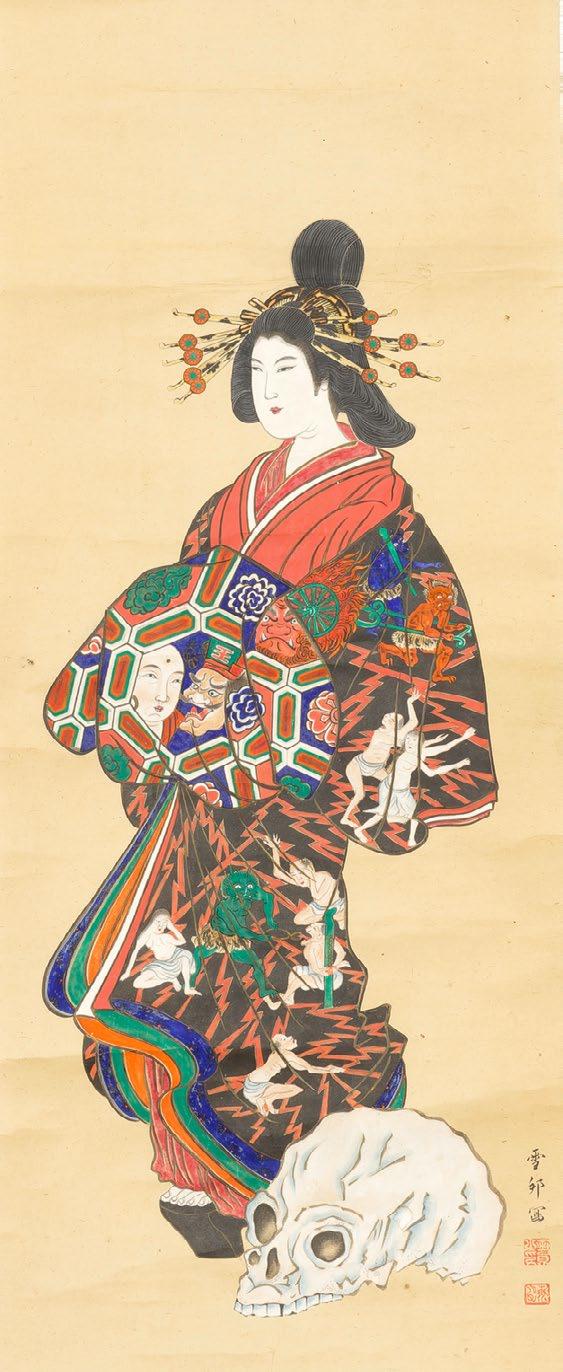
64 - ASIAN ART SOCIETY

japa N ese dem ON mas K sa K e C up
W i TH s TO ra G e
BOx
Japan 1804
Width: 12 cm
Length: 16 cm
height: 7 cm
price on request
Obje C t P R e S ented by:
Kitsune Japanese Art
M.: +32 476 87 85 69
E.: arie.vos@kitsune.be
W.:www.kitsunegaroo.com
A new year's or new season's (end of winter, beginning of spring) sakazuki (sake cup), shaped as an oni (demon) mask. These kind of sake cups are referred to as “oni wa soto, fuku wa uchi” (demons out, happiness in). the Japanese symbolically drink sake from these cups to chase demons and bringing in happiness to their home and family. There is a festival known as “setsubun” (3rd of February) that uses the same principle (oni wa soto, fuku wa uchi) during which beans are thrown outwards their home to get the demons out (oni are scared of beans).
This item comes with an old storage box dated “Bunka 1st year (1804) New Year's eve” .
66 - ASIAN ART SOCIETY 22

april 2023 - 67
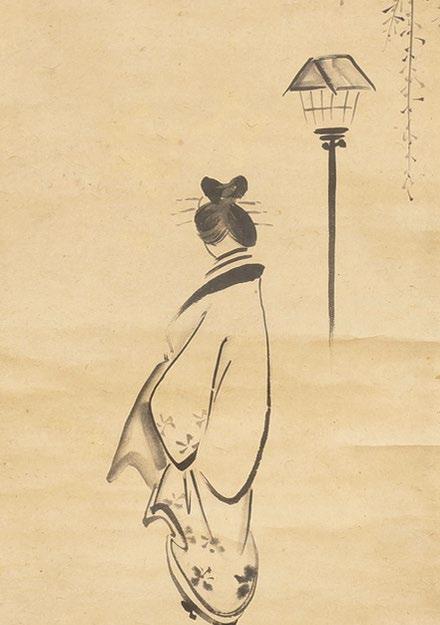
a B eau T y aT yO s H i W ara i N spri NG
Katsushika hokusai (1760-1849).
Signed as hokusai iichi (painting),
Shokusan o utsushi (poem), Seal: A stylized seal of Hokusai – Manji
Japan
Circa 1820
paper, ink, light colour, textile mount and hanging, the Jikusaki is made of glass
195 x 36 cm overall
131 x 30 cm painting
tomobako
provenance:
Attestation document by ota nanpo (ota Shokusanjin) who also inscribed the poem on the painting price on request
poem: ota nanpo (1749-1823)
Inscription on the painting : Poem: “Yoshiwara wa, hana no sakari to, nari ni keri, yoshino wa hadashi, keisei wa geta, Shokusan'o utsushi”
“Ah Yoshiwara!, It's approaching the height of the cherry blossom season, walking in bare feet on wooden sandals in the Keisei pleasure quarter, inscribed by Shokusan'o (Ota Nanpo)”
the word Keisei 傾城in the poem literally means “A castle topples over”. this refers to a beautiful woman who worked as a high ranking courtesan at the Yoshiwara pleasure Quarter. in this painting, hokusai painted the courtesan under a weeping cherry flower tree and showing only three-quarters of her profile. The word hadashi in the poem has the double meaning of bare feet 裸足and freshly emerging leaves
Obje C t P R e S ented by:
Galerie Mingei
M: +33 (0)6 09 76 60 68
E: mingei.arts.gallery@gmail.com
W: www.mingei.gallery
april 2023 - 69 23
葉出し
70 - ASIAN ART SOCIETY
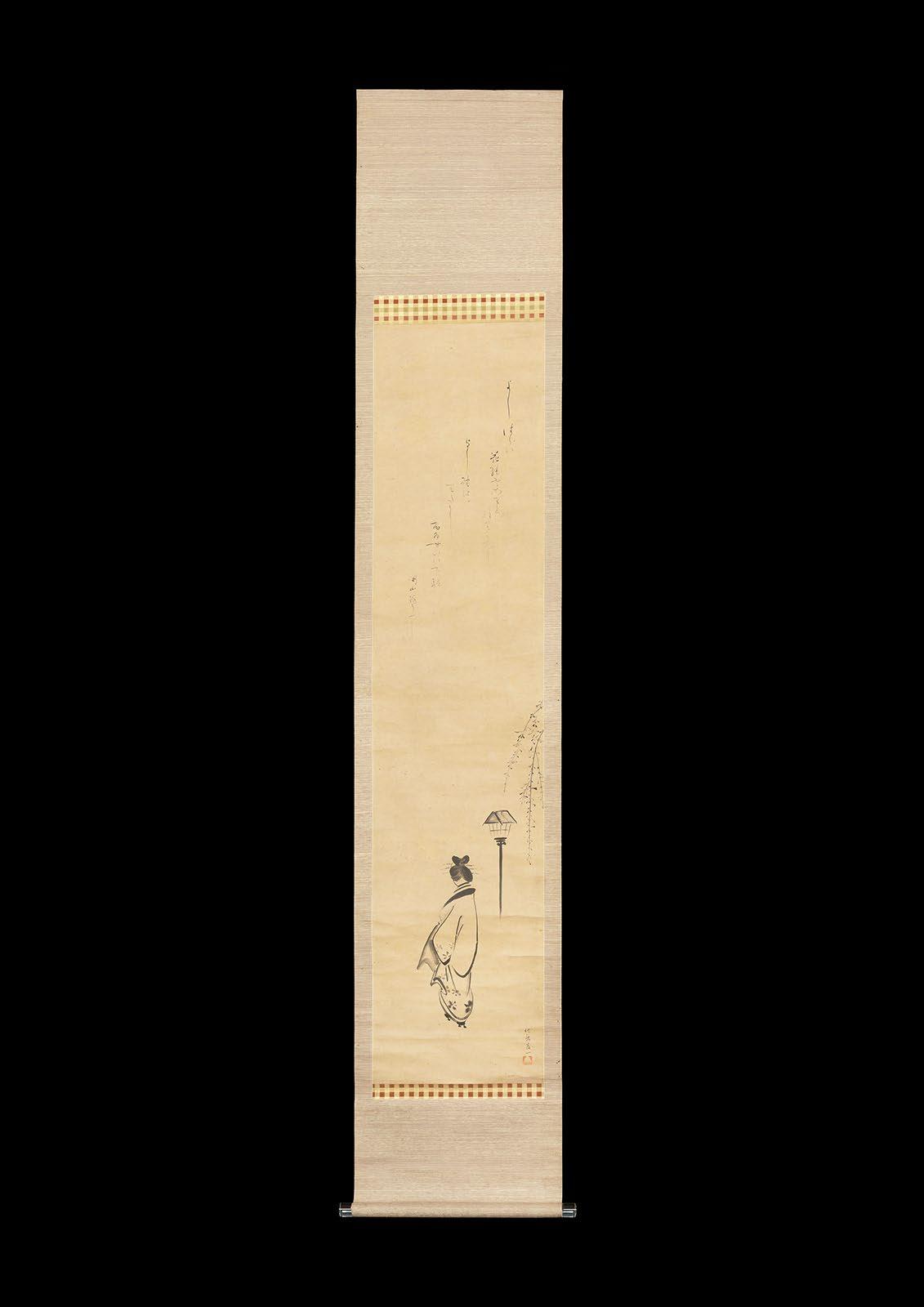

sTa N di NG a mida
Japan
Early Edo period
18th century
Gilded wood height: 55 cm
provenance: Belgian private collection price on request
,this gilded wooden sculpture depicts Amitabha (Amida in Japanese) standing in a delicately folded robe. the right arm is raised and the left arm is extended, the index finger and thumb of each hand forming a circle representing the mudra of the teaching, welcoming the believer into the Land of bliss, over which he rules.
the head has gyokugan, i.e. inlaid crystal eyes. the face has a calm expression, with almost closed eyes, under delicately arched eyebrows. the hair is arranged in rows of curls that also cover the ushnisha, the protrusion on the head. The drapery falls to the feet in elegant and refined folds. the great serenity that emanates from the sculpture corresponds to codes of representation found in 11th century Japan.
Amitabha Buddha has been venerated in Japan since the 7th century. The Buddha of the Future, also called "the immeasurable light" (hence the custom of gilding the statues), is associated with Mahayana Buddhism and the Pure Land Buddhism. It was Shākyamuni Buddha who introduced to our world the Land of bliss of Amitābha Buddha, a pure, virtuous, blissful world, devoid of evil, suffering and spiritual and material impurities, which is called the pure Land and which becomes the name of a widespread school in the Far East.
Amida's attribute is a lotus, and he is sometimes represented in the trinity - with Bodhisattvas bodyguards - Kannon (Avalotitesvara) and Seishi (Mahasthamaprata).
this is a remarkably large and well-preserved representation of the skill of Japanese crafts.
Obje C t P R e S ented by:
Christophe hioco
t: +33 (0) 1 53 30 09 65
E: info@galeriehioco.com
W: www.galeriehioco.com
april 2023 - 73 24
74 - ASIAN ART SOCIETY
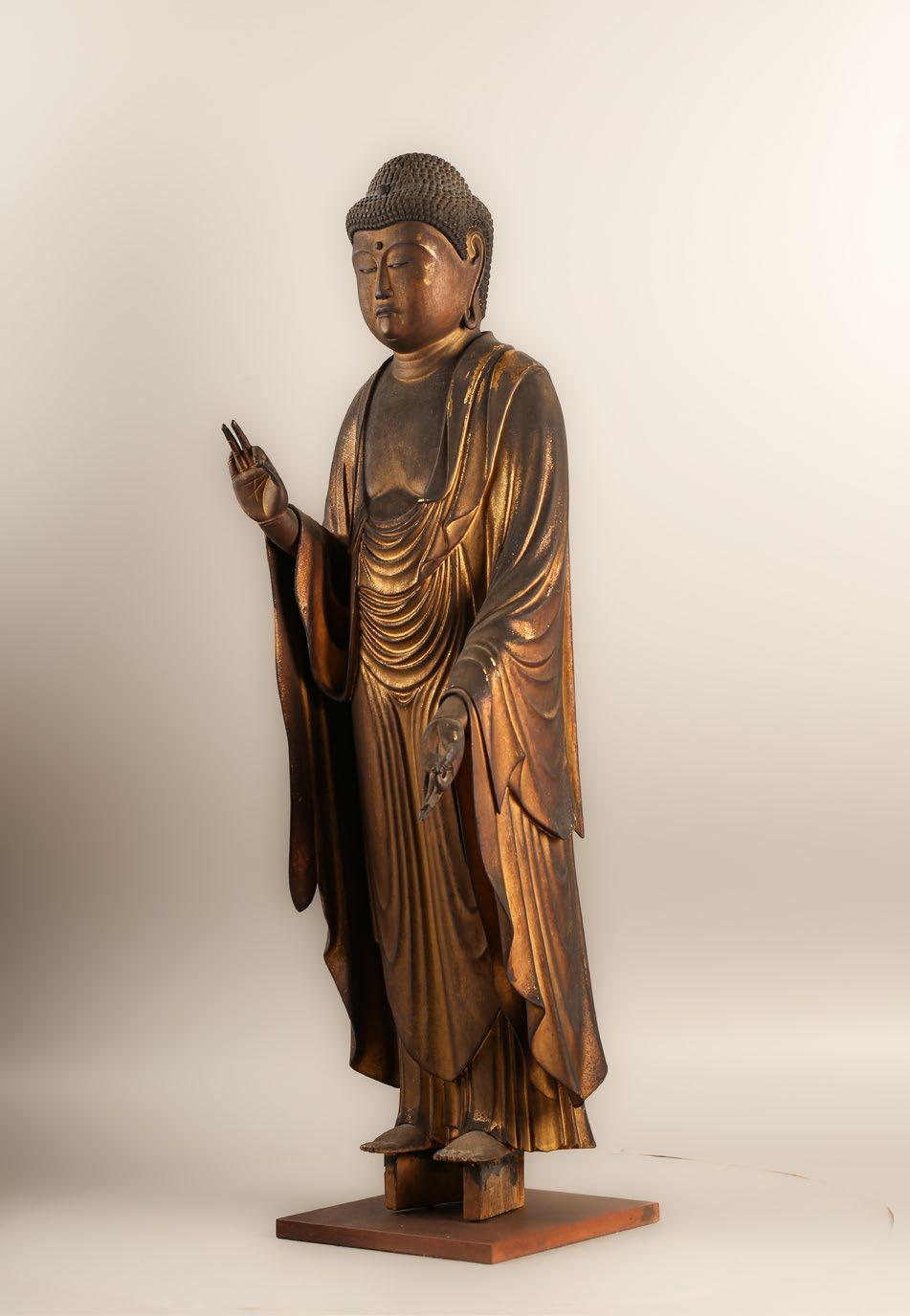
april 2023 - 75
Negoro candle holder; beautifully worn at some places, revealing the black lacquer coating.
r ed la C quered
C a N dles T i CK
Japan
Muromachi period
16th century
height: 29,5 cm
price on request
Obje C t P R e S ented by:
Kitsune Japanese Art
M.: +32 476 87 85 69
E.: arie.vos@kitsune.be
W.:www.kitsunegaroo.com
76 - ASIAN ART SOCIETY
25
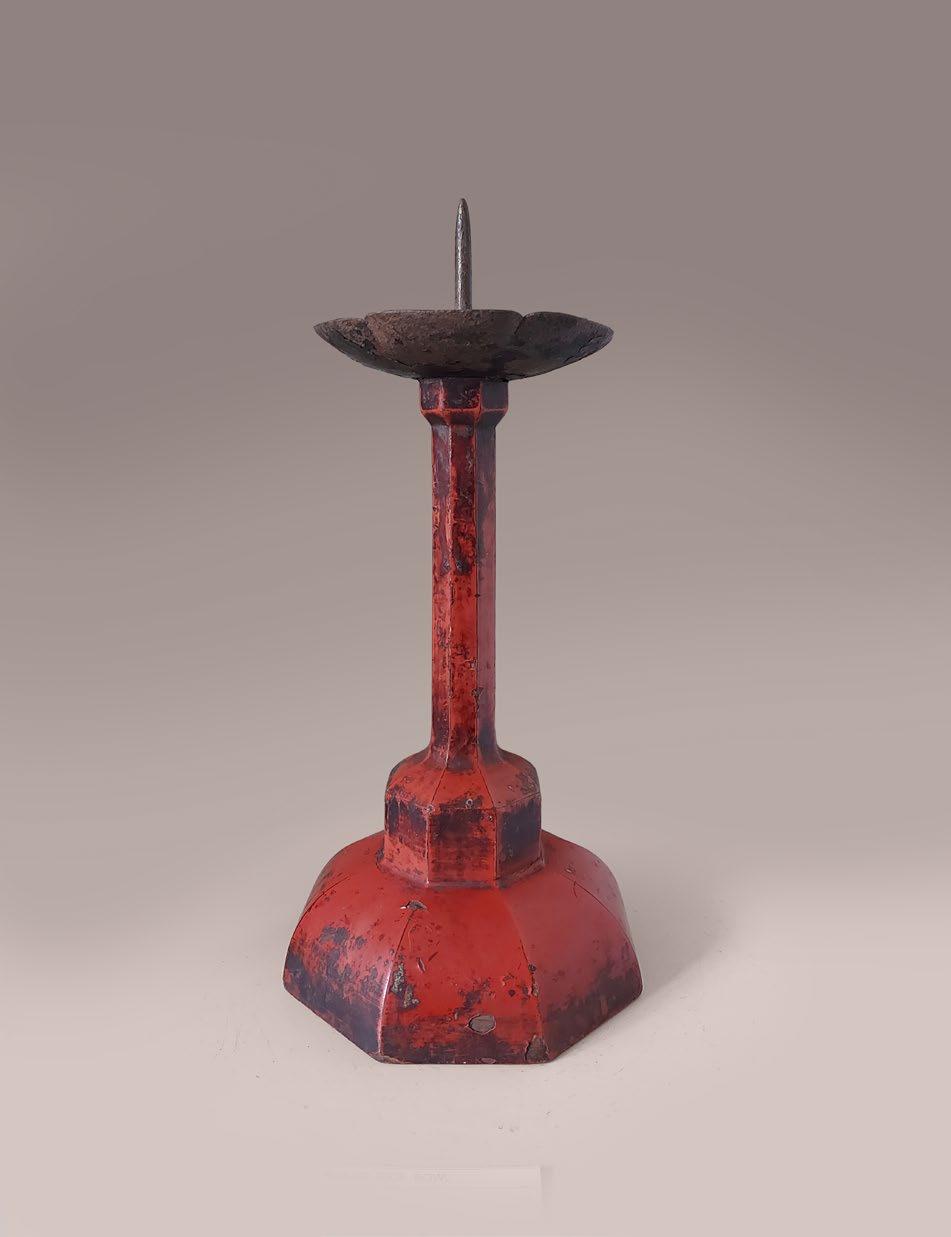
april 2023 - 77
d ei Ga N
Japan
Edo period 17th-18th century
Wood, gesso, polychrome pigments, and gold accents
21,2 cm (h) x 13,7 cm x 6,8 cm
Kiribako storage box price on request
Obje C t P R e S ented by:
Galerie Mingei
M: +33 (0)6 09 76 60 68
E: mingei.arts.gallery@gmail.com
W: www.mingei.gallery
the noh play Lady Aoi (Aoi no ue) by Zeami is based on Chapter 9, “Leaves of Wild Ginger” (Aoi).
Lady Aoi, Genji's first wife, is possessed by a spirit during childbirth and becomes seriously ill.
The culprit appears to be the vengeful spirit of Genji's neglected former lover, Lady Rokujō, humiliated by Aoi during the “battle of the carriages” scene. Lady Rokujō first appears on stage seeking retribution, wearing the deigan (Lit. “gilded” or “golden eyes”) mask.
the mask represents a mature woman who carries within her the seeds of supernatural transformation, while simultaneously signaling a demonic spirit that will soon manifest. the large, prominent forehead and gilded eyes are its most distinctive features.
78 - ASIAN ART SOCIETY 26
SOLD
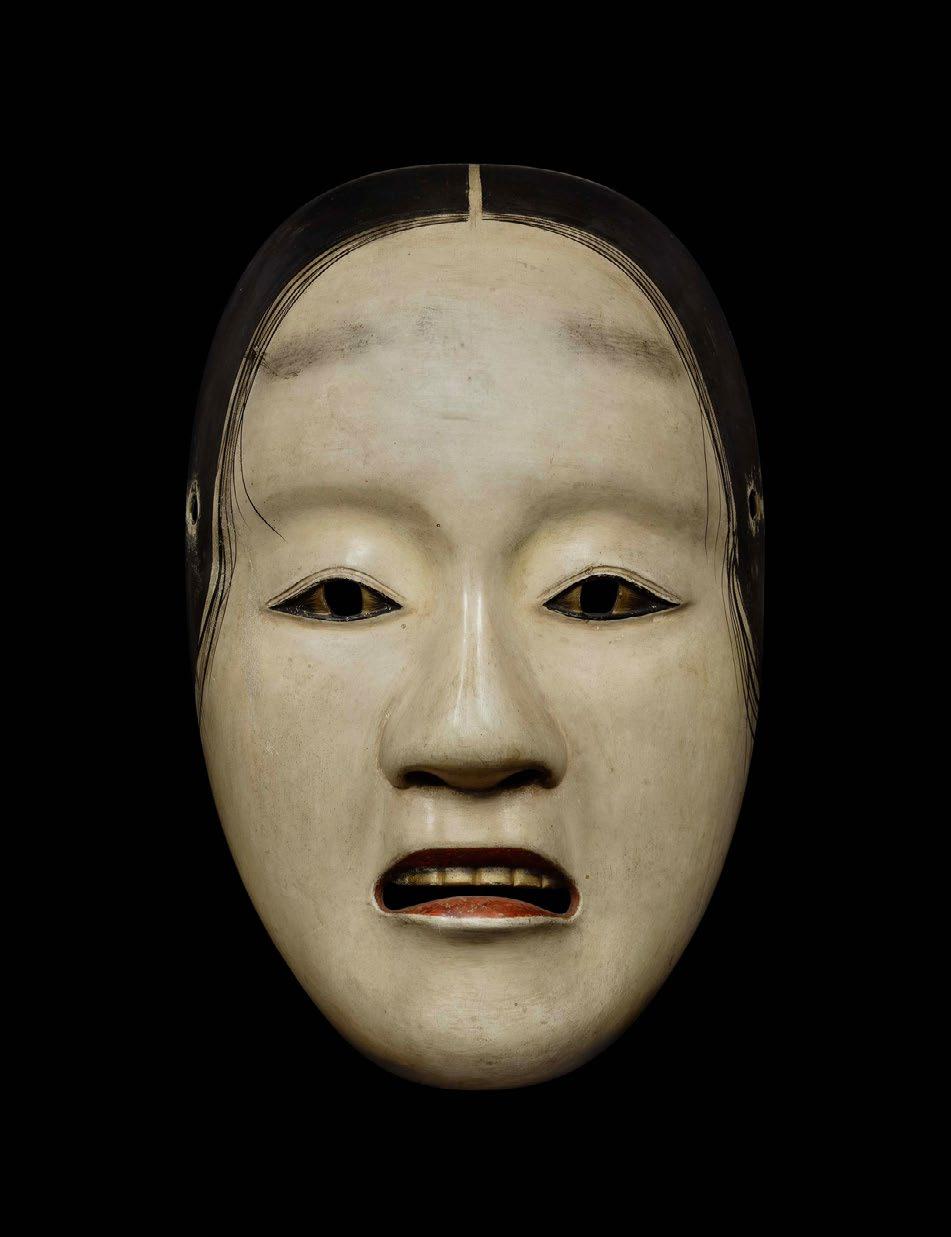
april 2023 - 79
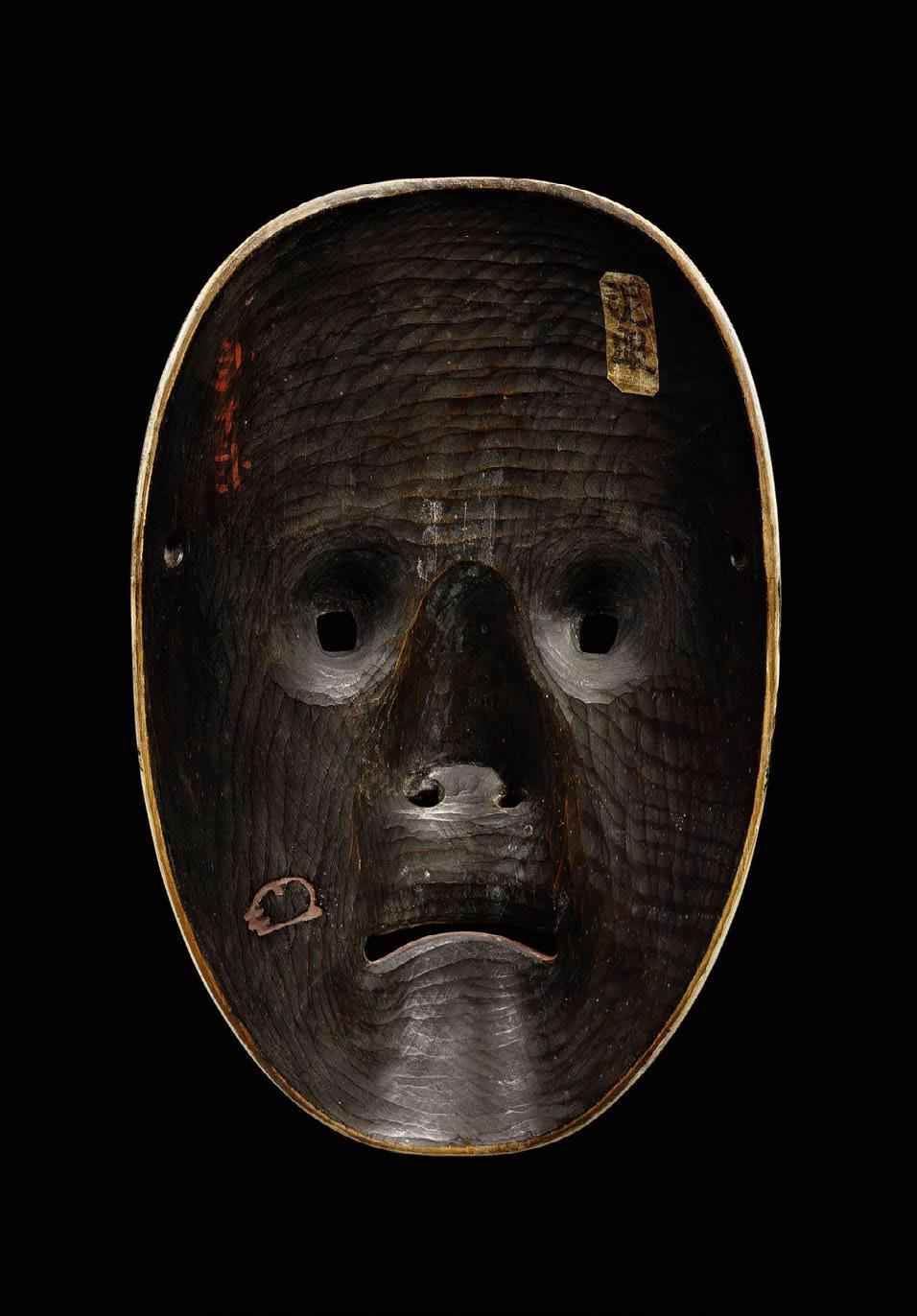
80 - ASIAN ART SOCIETY

april 2023 - 81
B O d H isaTT va H ead
Ancient region of Gandhara
3rd-4th century
Stucco height: 20 cm
provenance : French private collection. price on request
Obje C t P R e S ented by:
Christophe hioco
t: +33 (0) 1 53 30 09 65
E: info@galeriehioco.com
W: www.galeriehioco.com
this stucco Bodhisattva head comes from the ancient region of Gandhāra. Archaeological excavations have unearthed numerous stucco statues and fragments, revealing the importance of the use of this material in Gāndhāra. The production, of which this head is a part, covers the fervent religious reality of the early centuries of our era in this region. the artists of the period inspired vitality in their works through a very sensitive treatment of flesh and modeling, once emphasized by polychromy, which is almost invisible today on this piece but of which fragments remain in ink at the level of the eyelids, in their hollows as well as under the hair.
A bodhisattva is represented here, his face serene, his eyes half-closed, his regular features showing a real concern for naturalism. His fleshy lips, with deep corners and his straight nose are all elements that illustrate the influence of hellenistic art, which had a great posterity in the Gāndhāra. The hair is composed of elegant curls falling gracefully down the bodhisattva's neck. The top of his head is adorned with a headband, the details of which are somewhat blurred but whose refinement we can imagine in the image of the rest of the sculpture. Similarly, his left earlobe is distended and adorned with a heavy pendant, another element that anchors this representation in its context of creation while participating in the humanization of this representation.
82 - ASIAN ART SOCIETY 27
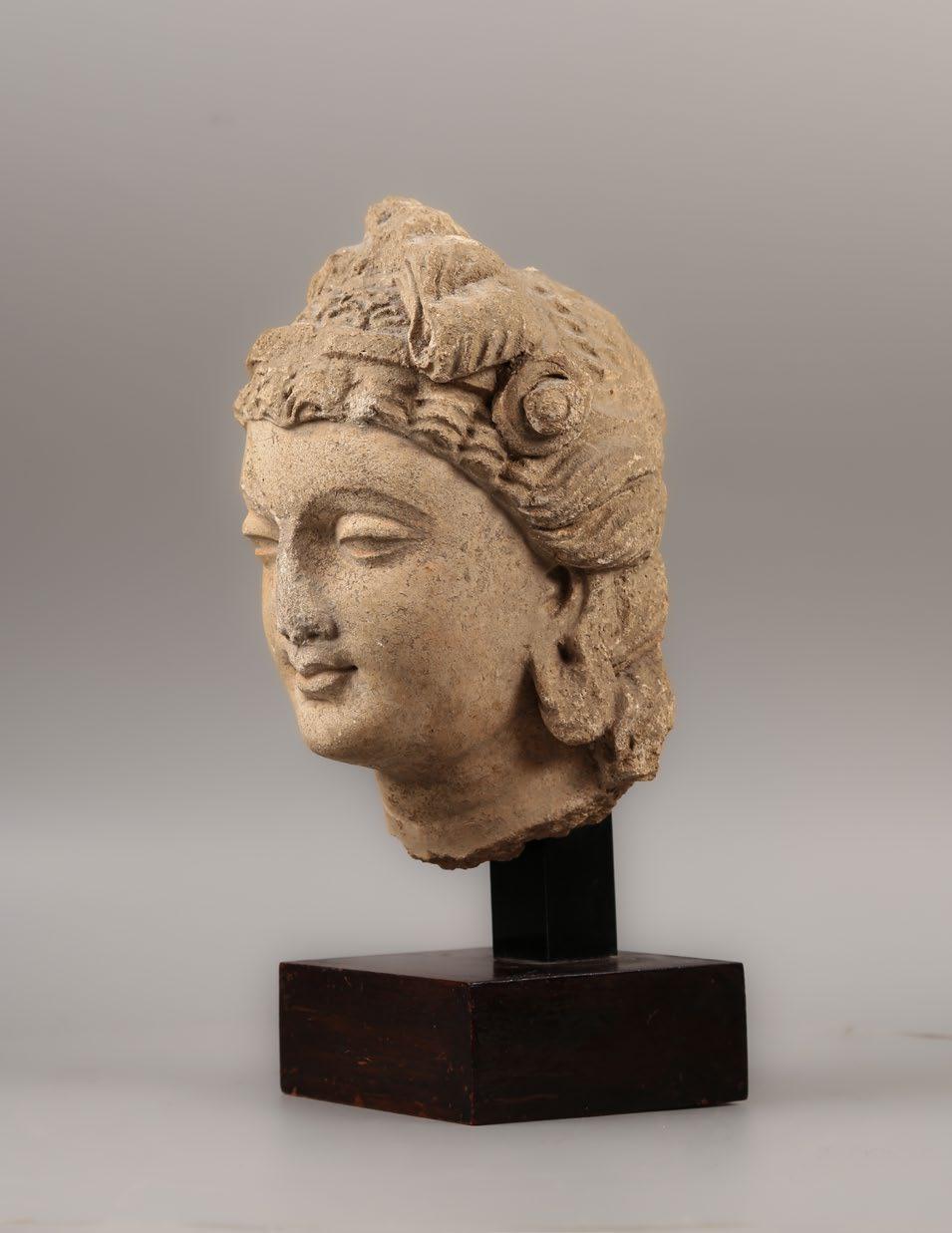
april 2023 - 83
84 - ASIAN ART SOCIETY


